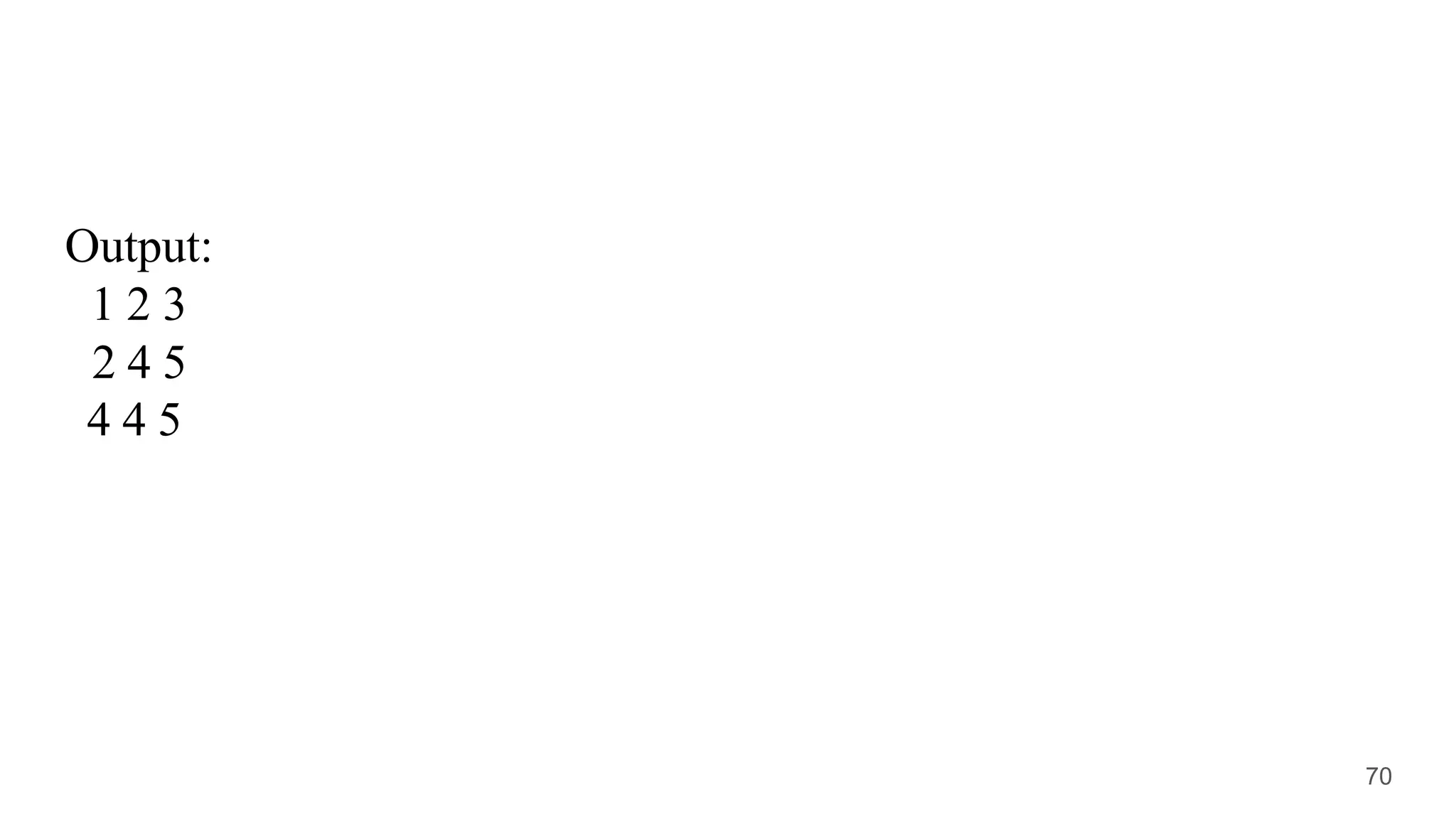This document provides an introduction to Java programming language and some of its core concepts. It discusses:
- The origins and features of Java like being architecture neutral, robust, multithreaded, object-oriented, platform independent, simple and secure.
- Basic Java syntax including classes, objects, methods, and variables.
- Key object-oriented programming concepts in Java like encapsulation, inheritance, polymorphism and abstraction.
- Examples of basic Java programs and code snippets demonstrating classes, objects, methods, variables and data types.
- Common programming structures in Java like control statements, operators, and constructors.
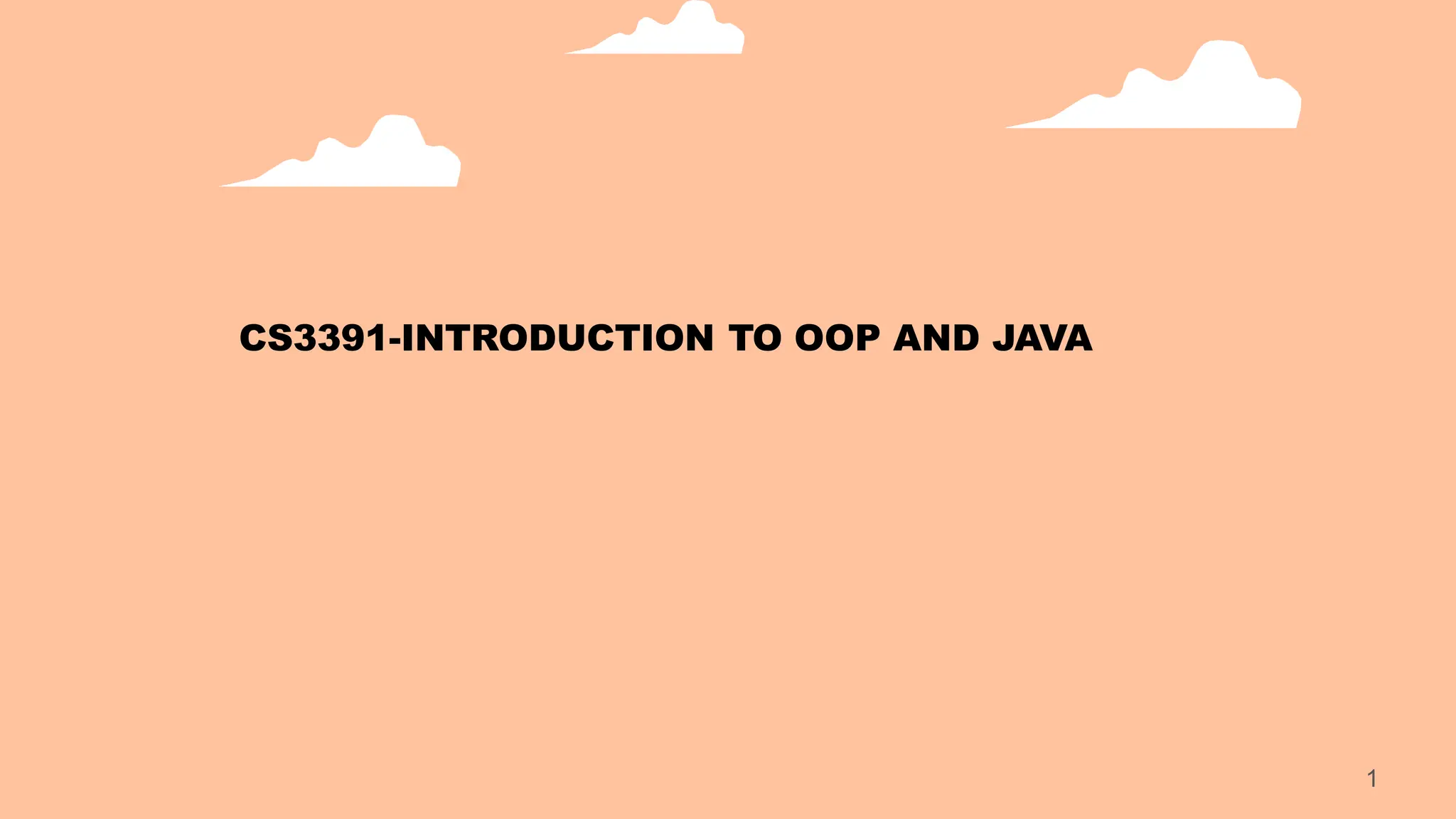
![Java programming language was originally
developed by Sun Microsystems which was
initiated by James Gosling and released in
1995 as core component of Sun
Microsystems' Java platform (Java 1.0 [J2SE]).
Java is guaranteed to be Write Once,
Run Anywhere.](https://image.slidesharecdn.com/indumathy-unit1-240416141759-7b11f0e0/75/INDUMATHY-UNIT-1-cs3391-oops-introduction-to-oop-and-java-pptx-2-2048.jpg)
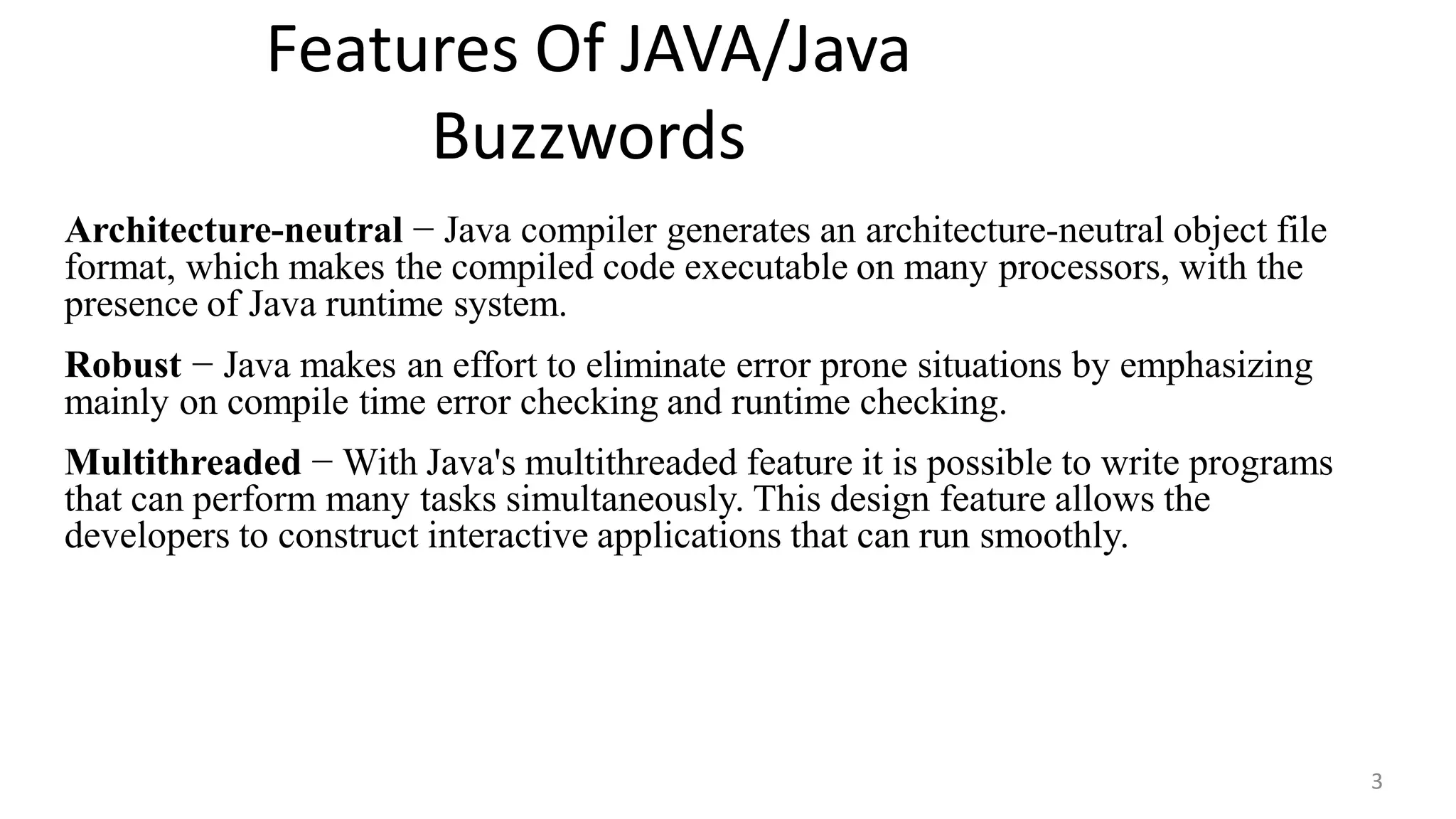

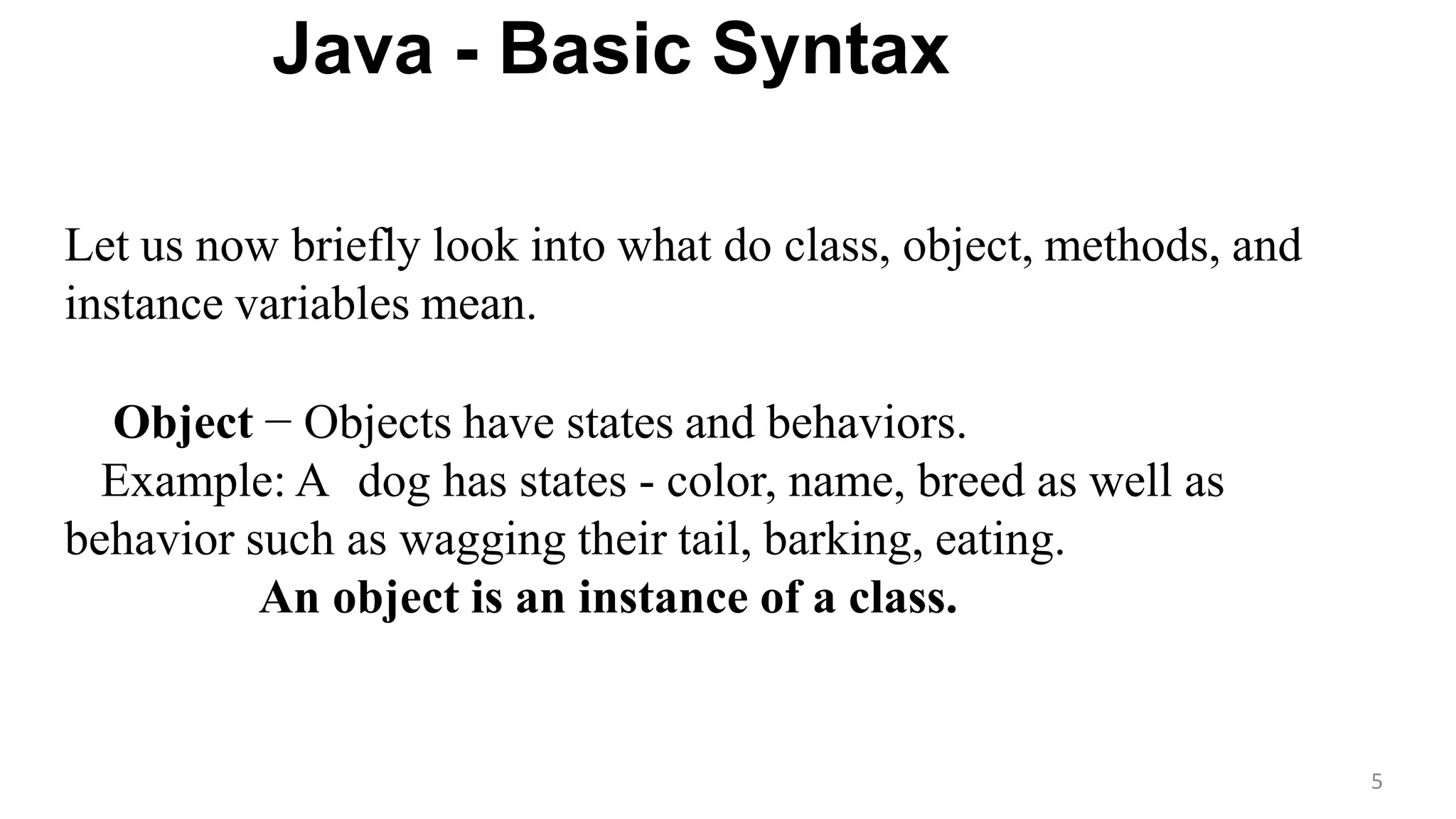

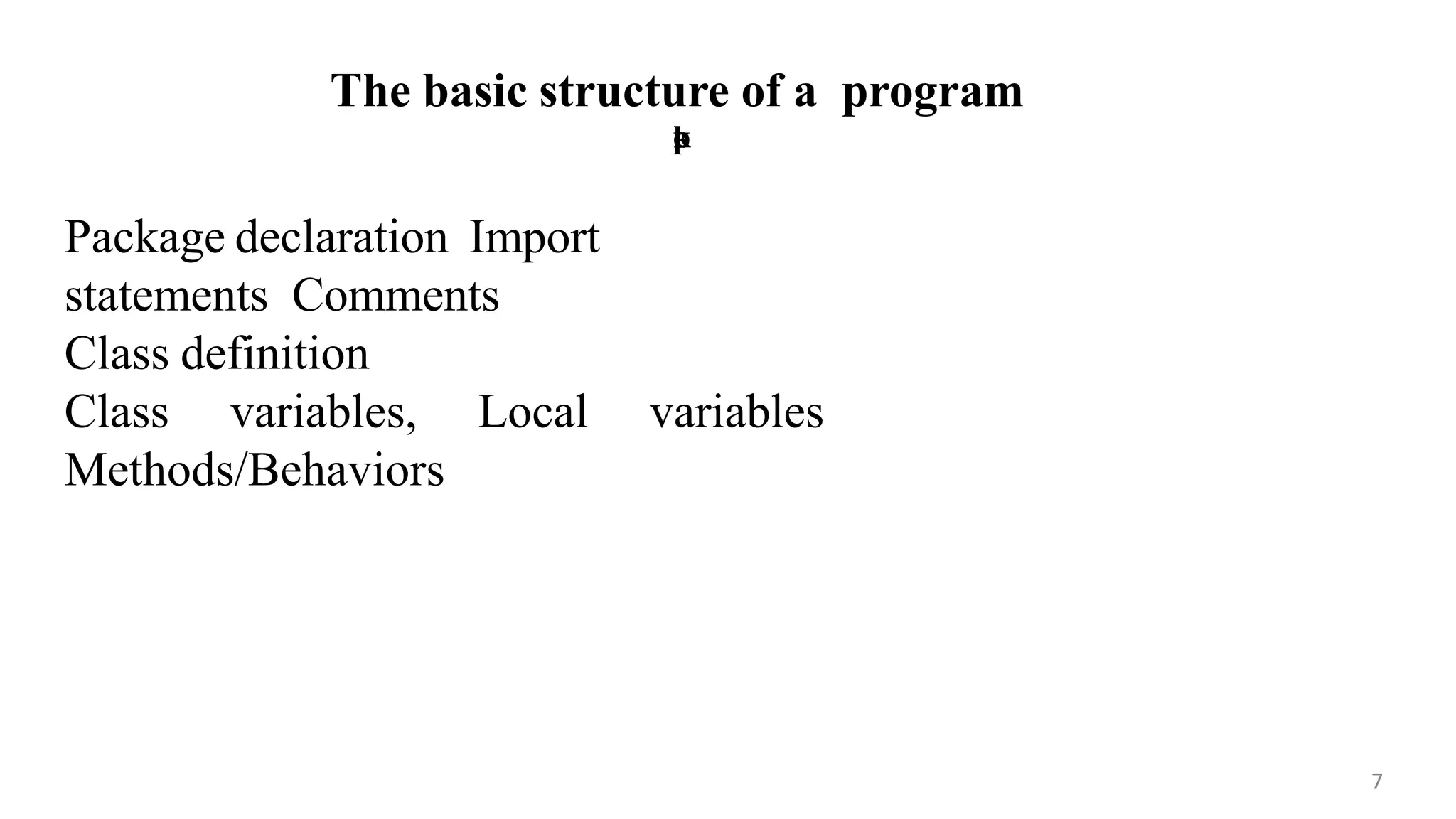
![package abc; // A package declaration
8
import java.util.*; // declaration of an import statement
// This is a sample program to understnd basic structure of Java (Comment Section)
public class JavaProgramStructureTest {
int repeat = 4;
public static void main(String args[]) {
// class name
// global variable
// main method
JavaProgramStructureTest test = new
javaProgramStructureTest();
test.printMessage("Welcome to Tutorials Point"); }
public void printMessage(String msg) // method
{
Date date = new Date(); // variable local to method
for(int index = 0; index < repeat; index++) { // Here index - variable local to
for loop
System.out.println(msg + "From" + date.toGMTString());
} } }](https://image.slidesharecdn.com/indumathy-unit1-240416141759-7b11f0e0/75/INDUMATHY-UNIT-1-cs3391-oops-introduction-to-oop-and-java-pptx-8-2048.jpg)
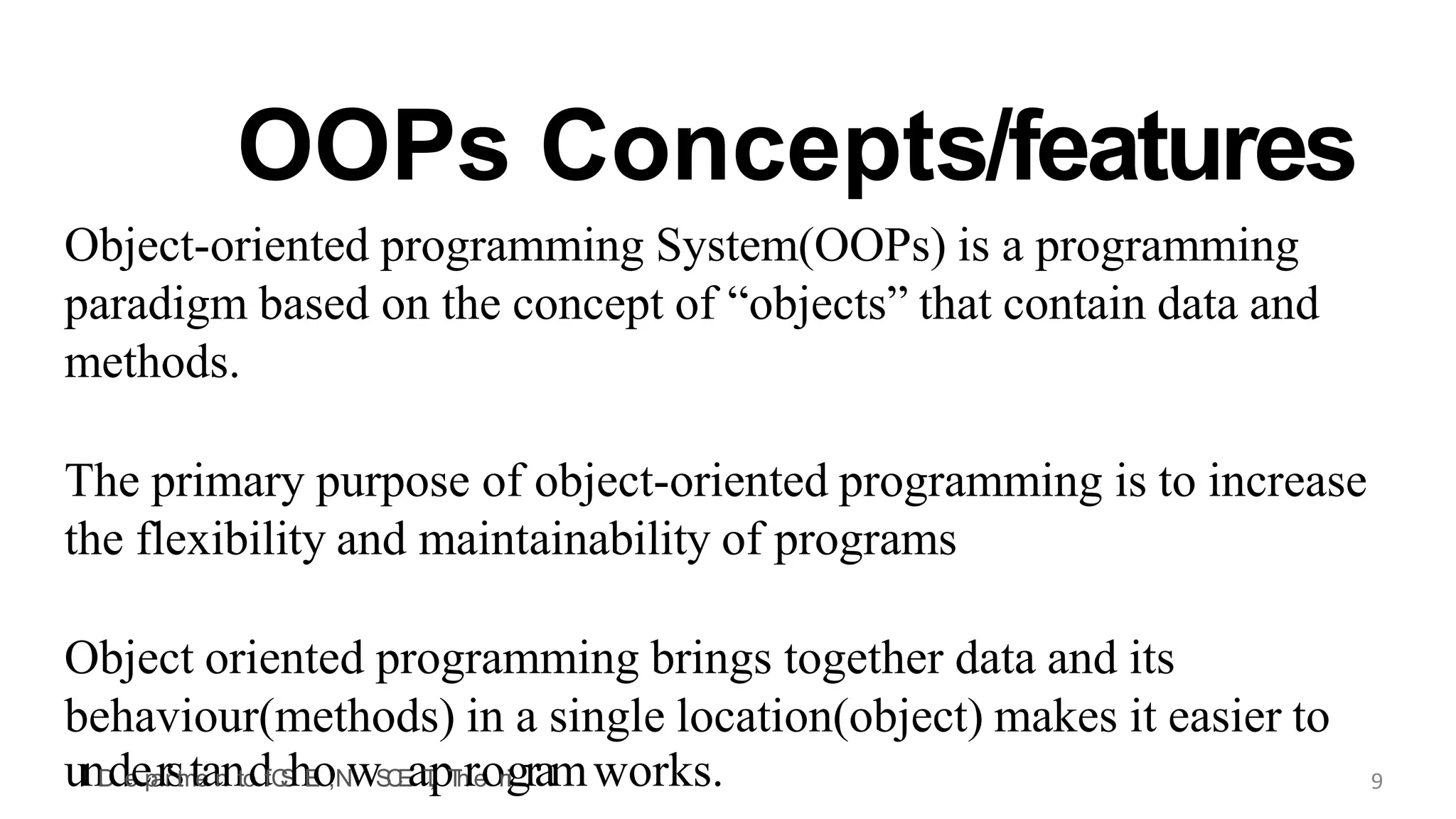
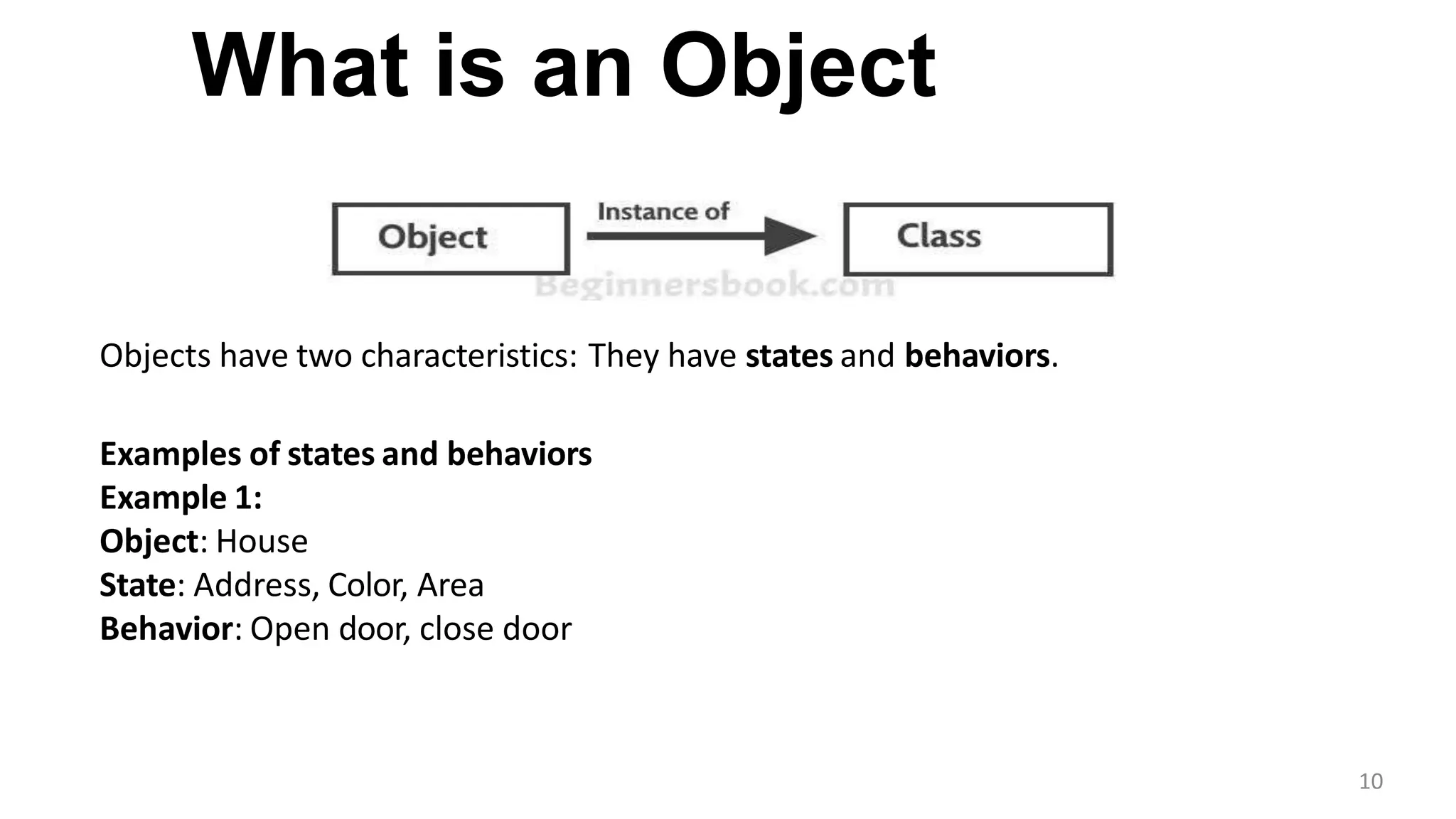
![class House
{
11
String address;
String color;
double area;
void openDoor()
{
System.out.println(“open the door”);
}
void closeDoor()
{
System.out.println(“Close the door”);
}
public static void main(String a[])
{
House a = new House();
a.openDoor();
a.closeDoor();
}](https://image.slidesharecdn.com/indumathy-unit1-240416141759-7b11f0e0/75/INDUMATHY-UNIT-1-cs3391-oops-introduction-to-oop-and-java-pptx-11-2048.jpg)
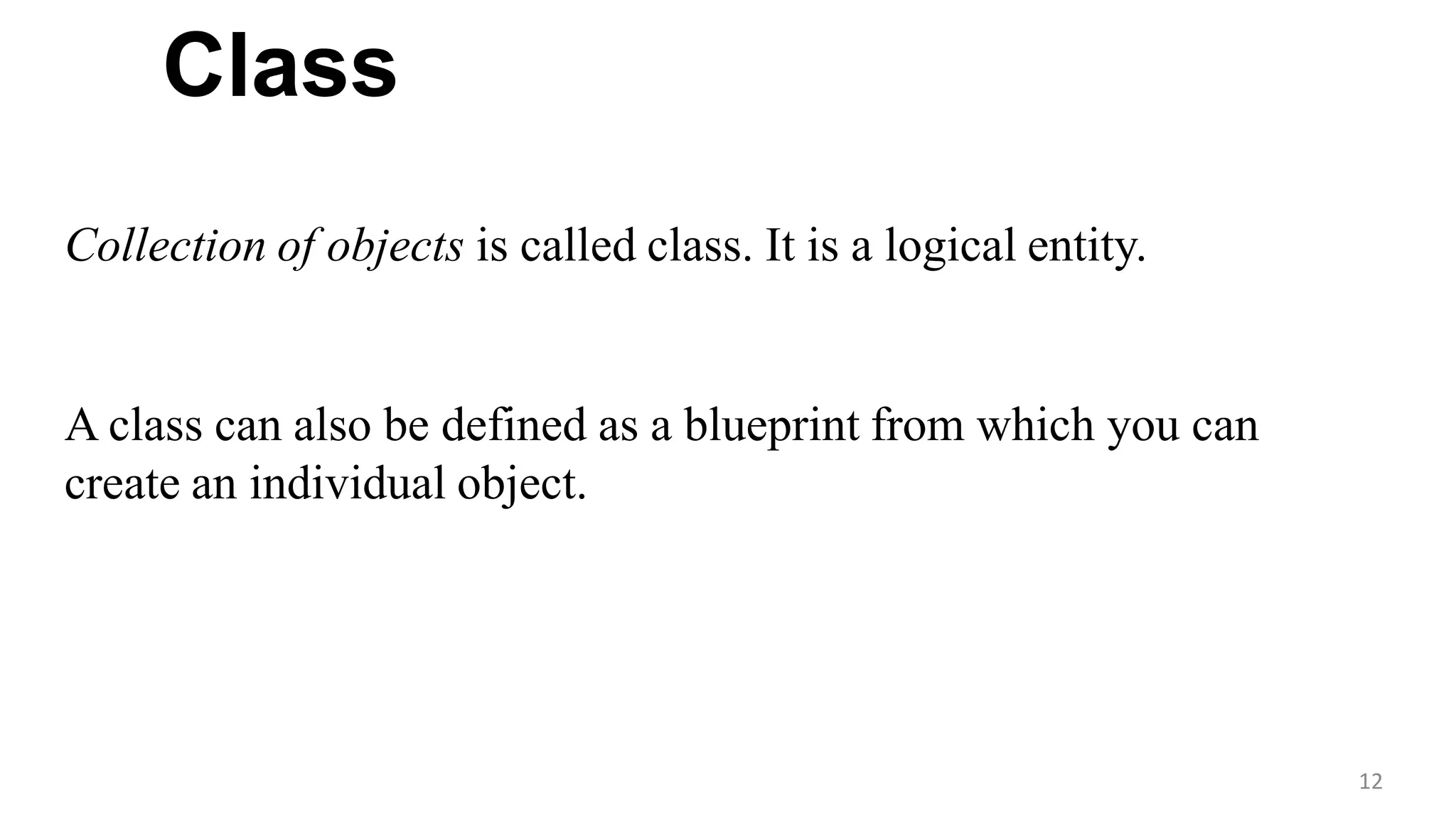
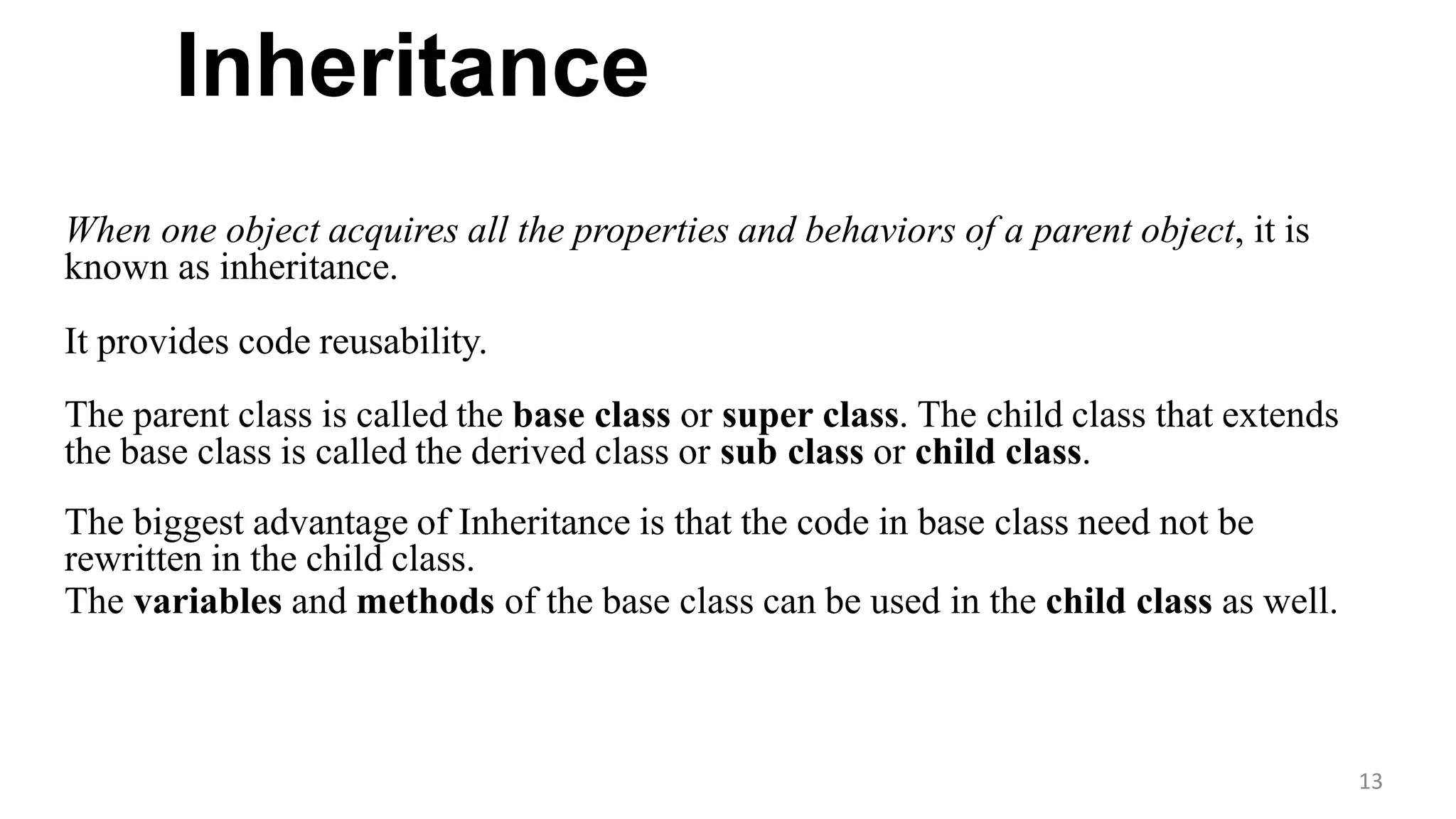
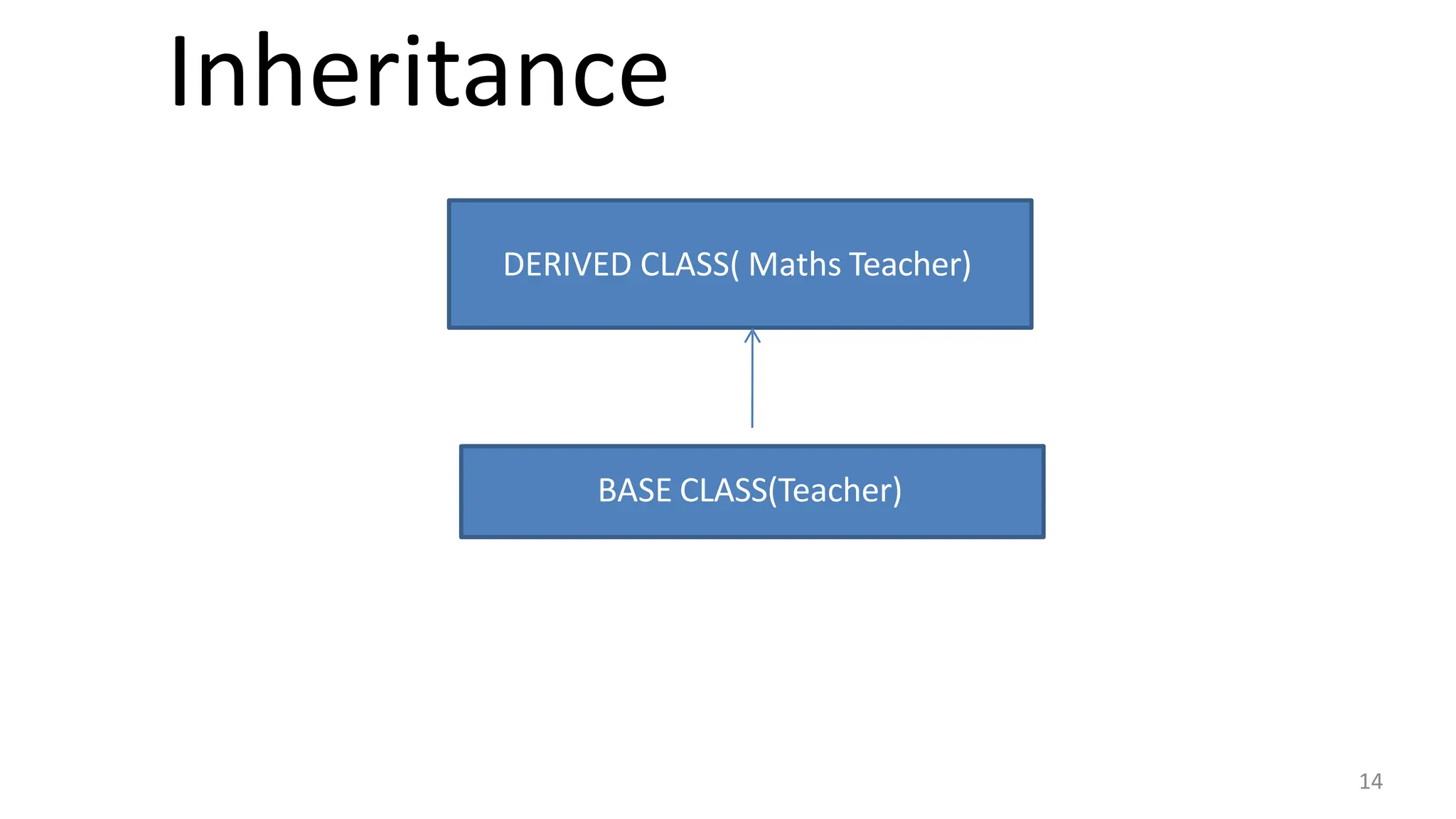
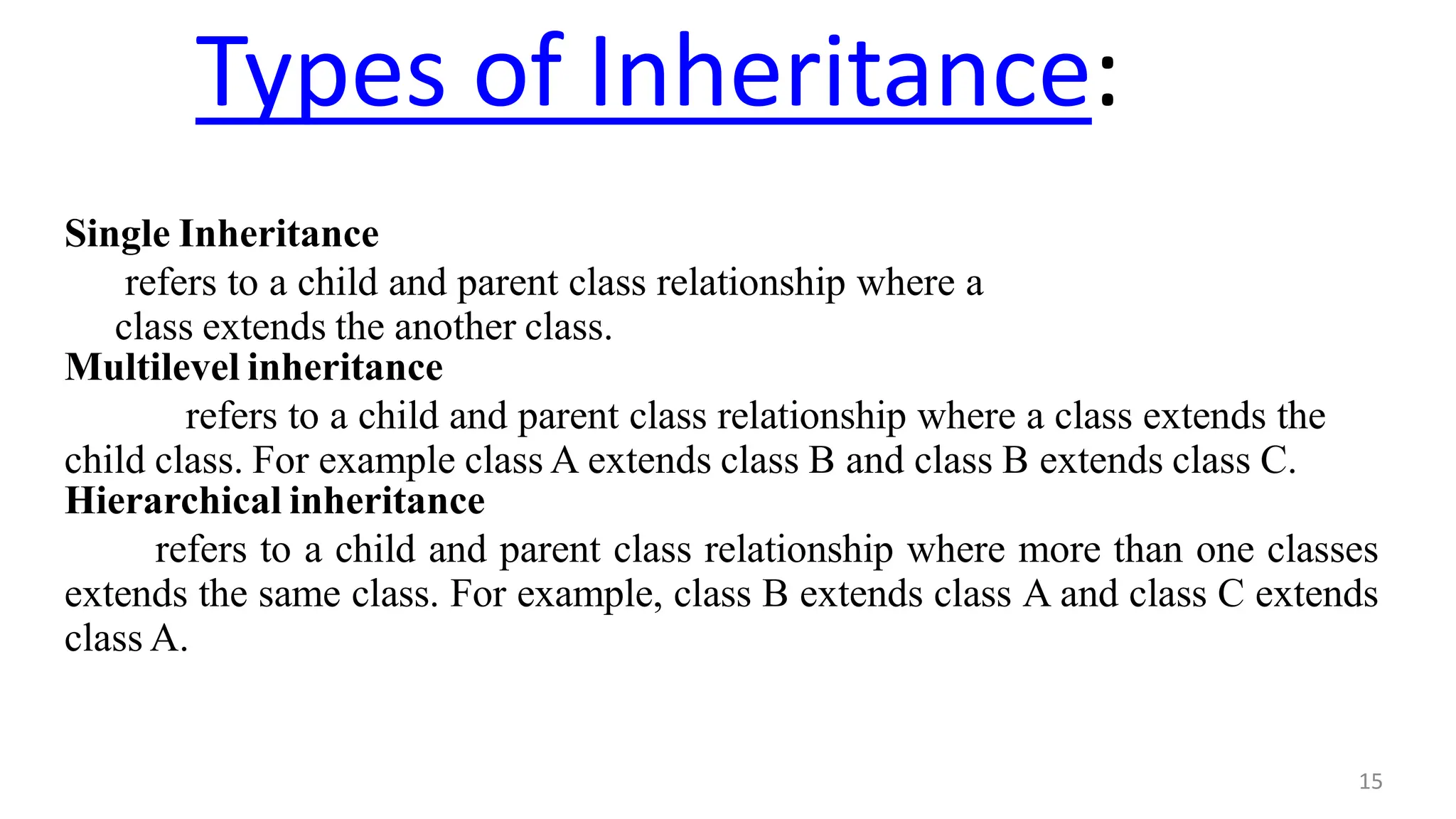


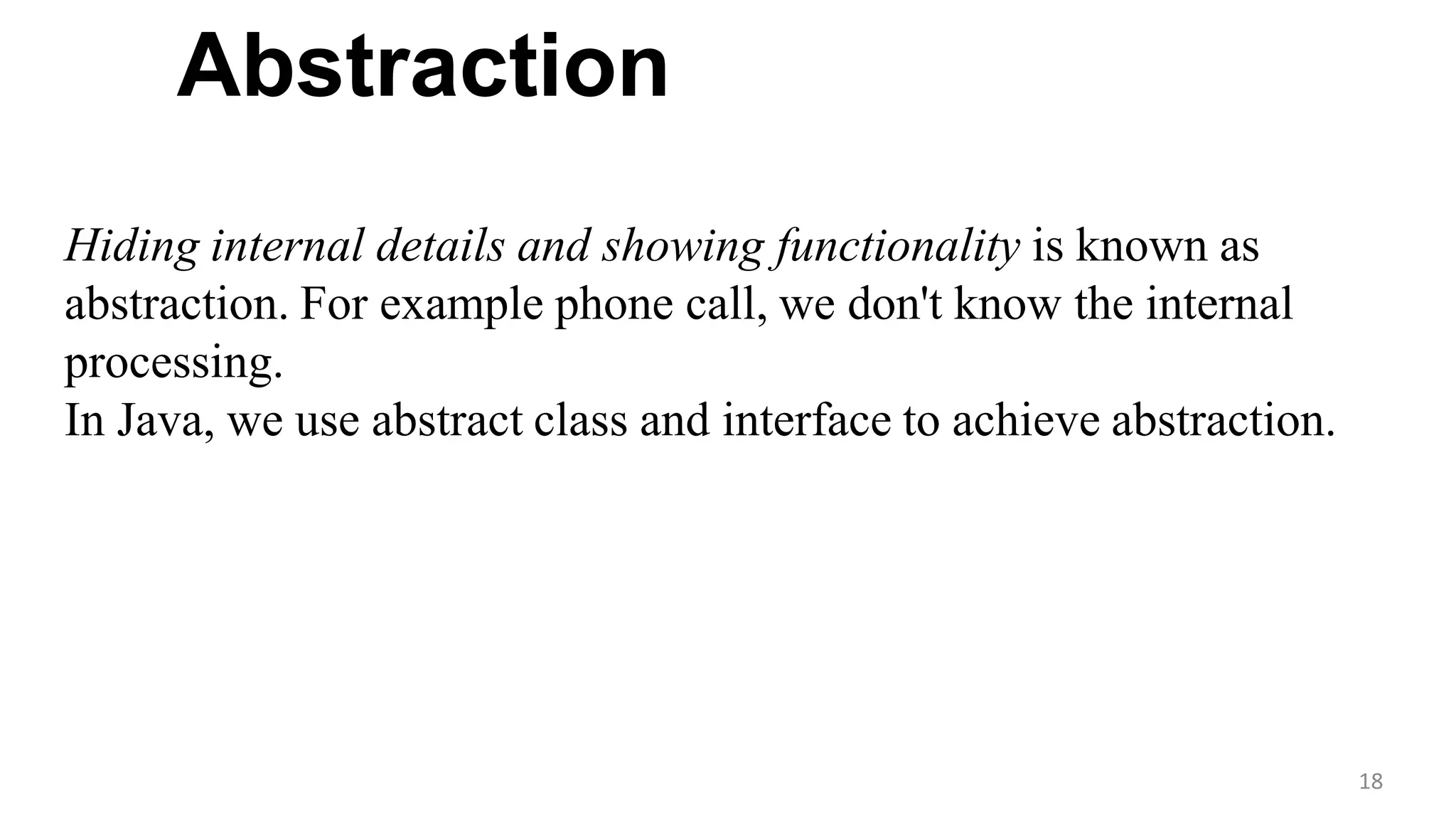
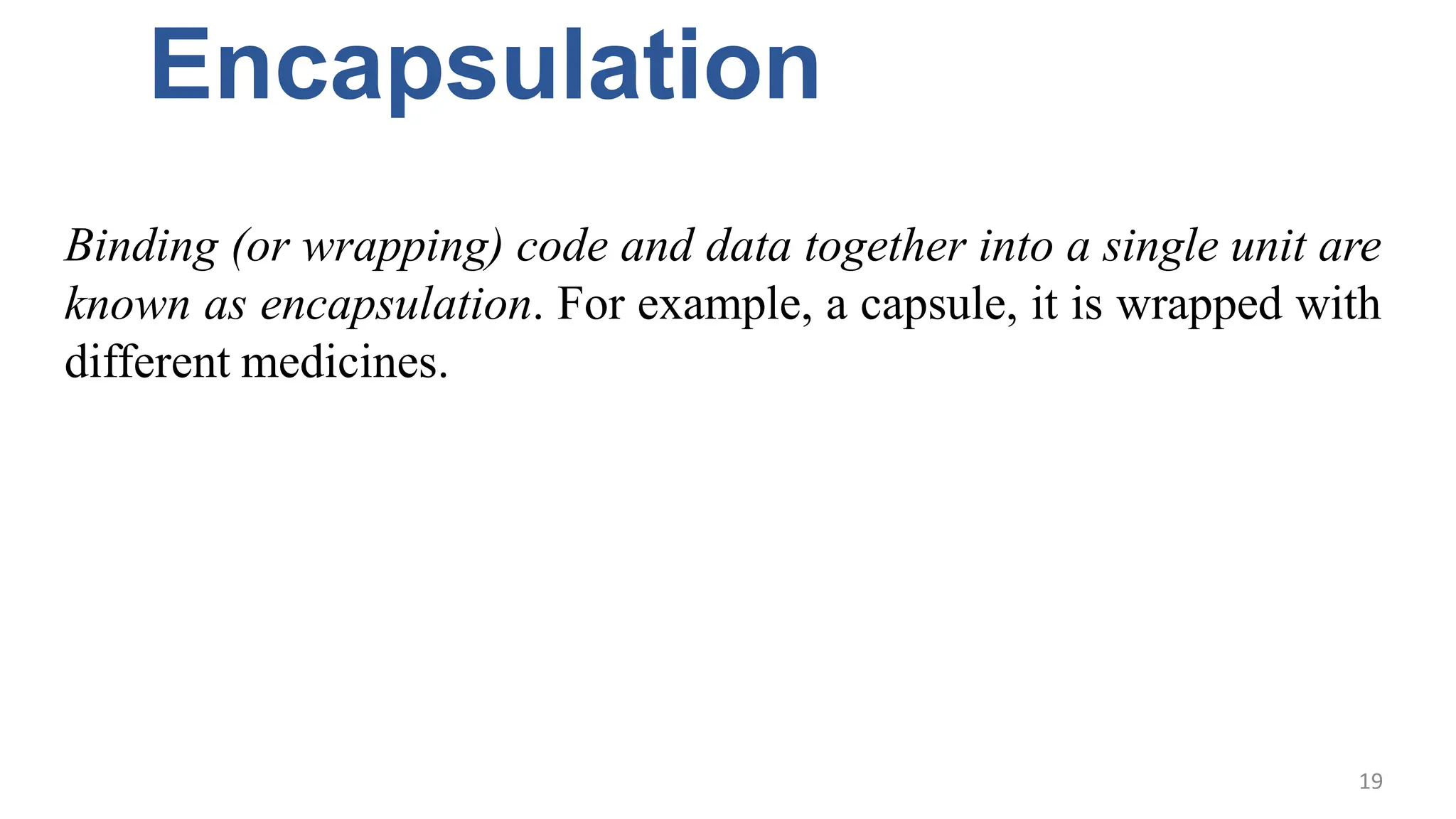
![SAMPLE PROGRAMS
20
import java.util.Scanner;
public class HelloWorld
{
public static void main(String[] args)
{
Scanner reader = new Scanner(System.in);
System.out.print("Enter a number: ");
int number = reader.nextInt();
System.out.println("You entered: " + number);
}
}
OUTPUT:
Enter a number: 10
You entered: 10](https://image.slidesharecdn.com/indumathy-unit1-240416141759-7b11f0e0/75/INDUMATHY-UNIT-1-cs3391-oops-introduction-to-oop-and-java-pptx-20-2048.jpg)
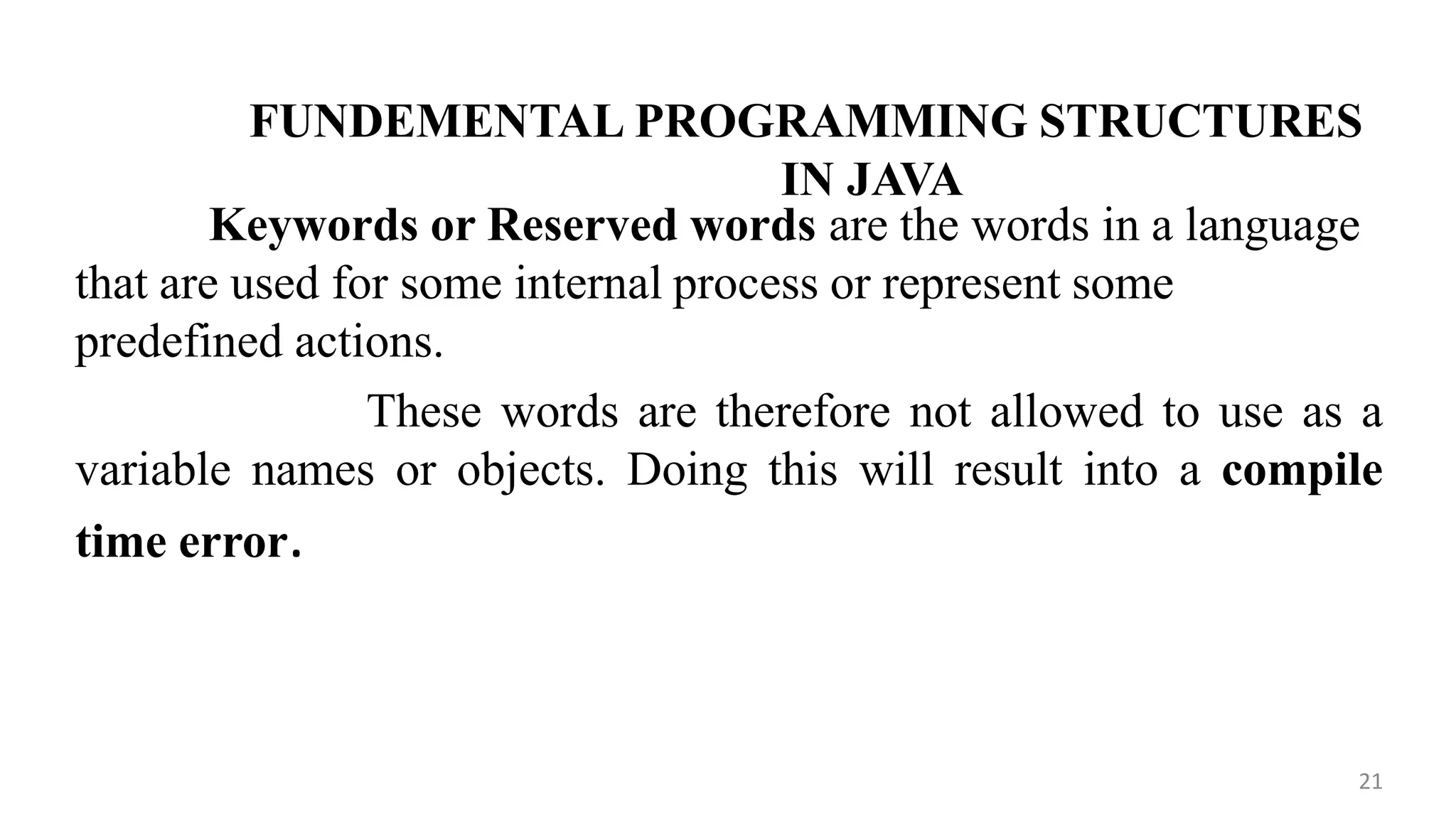
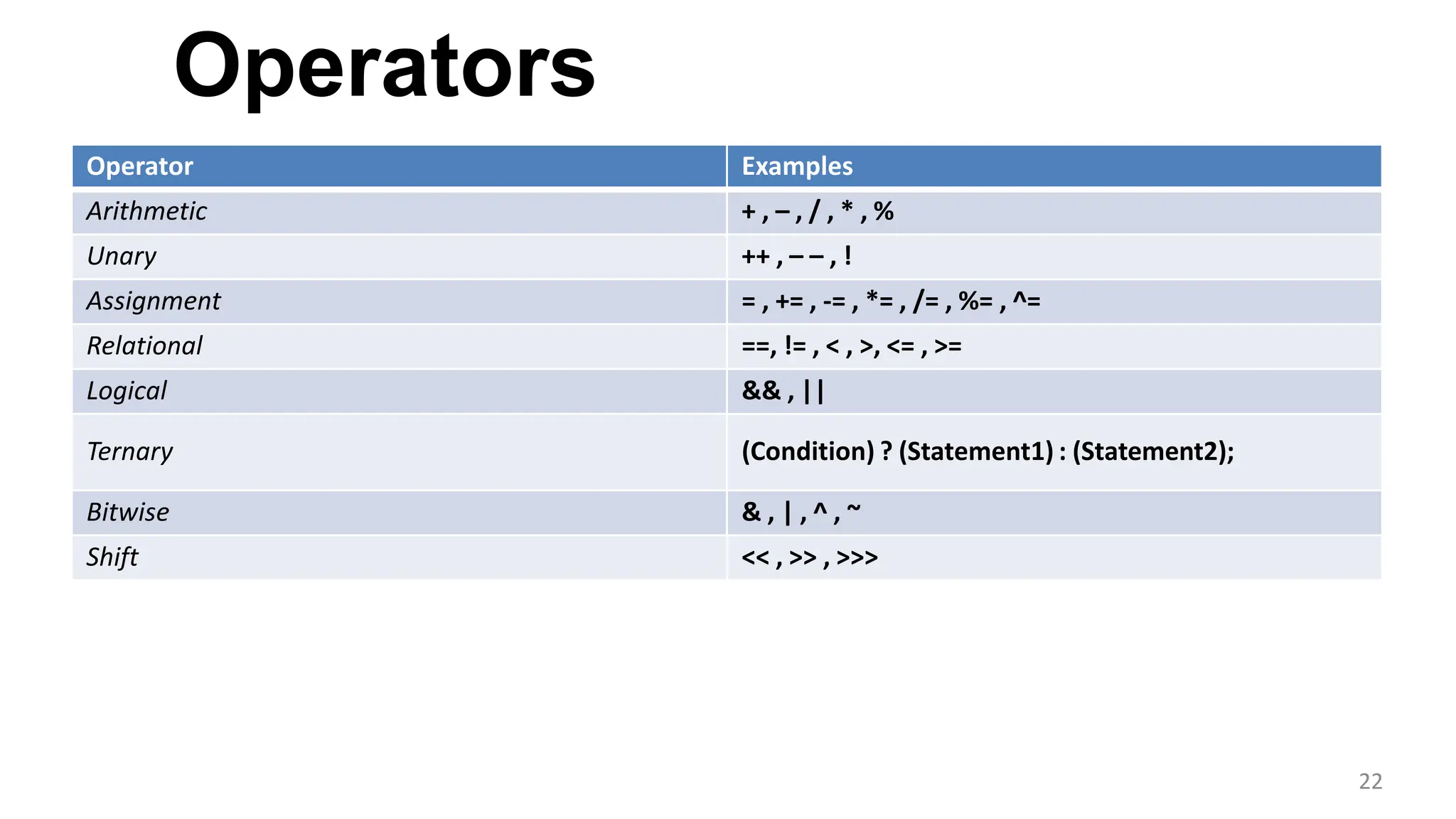
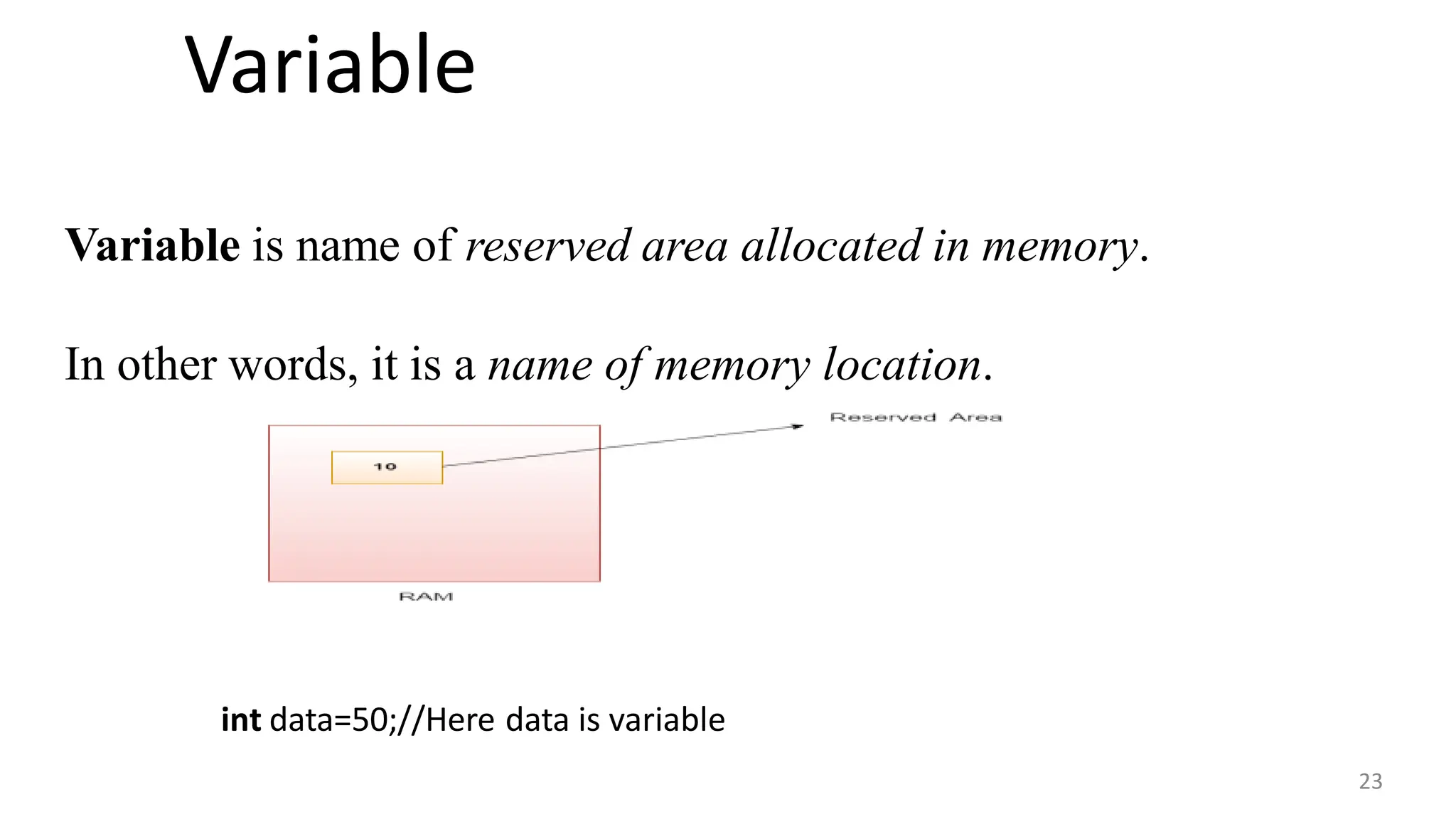
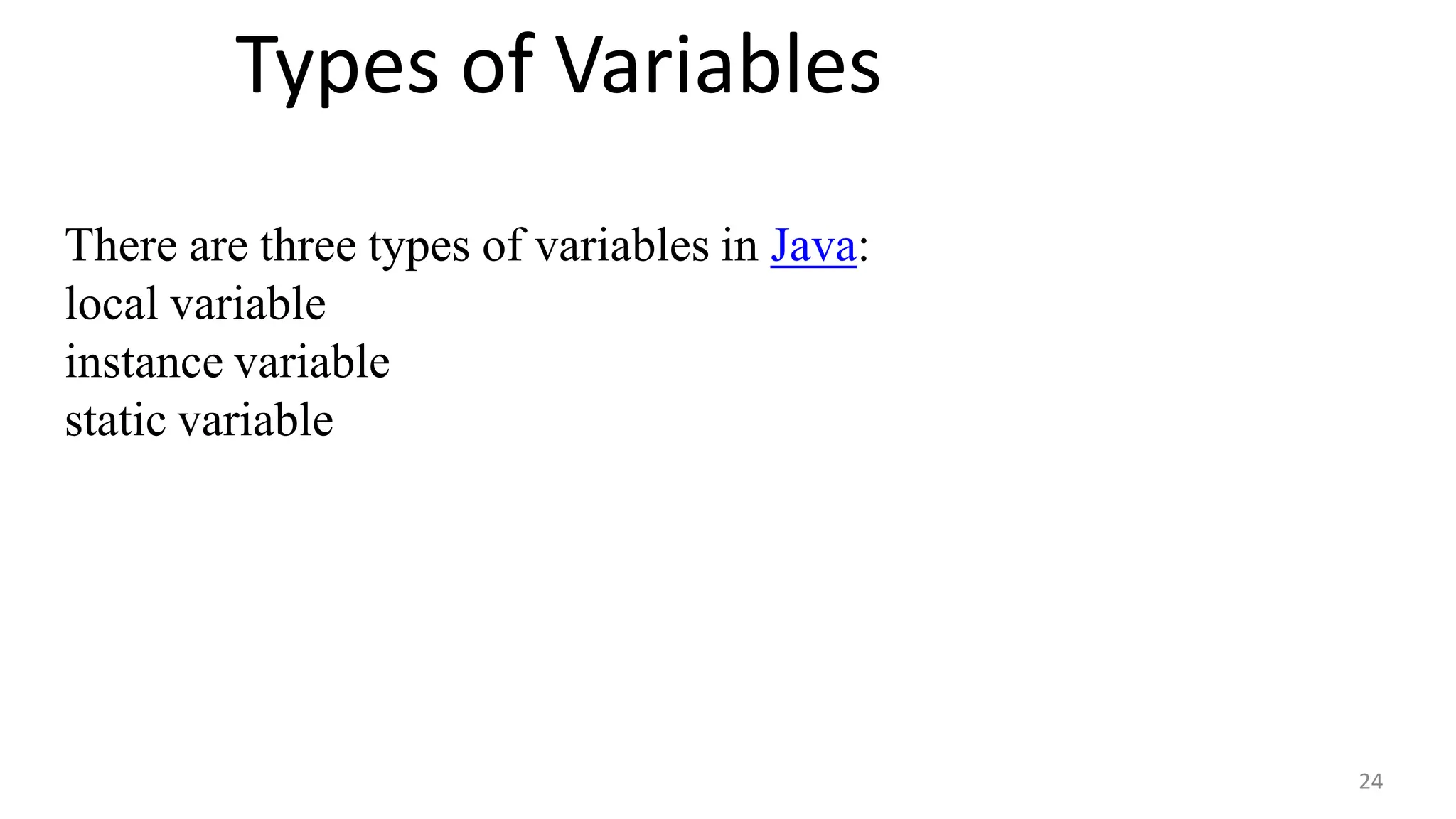
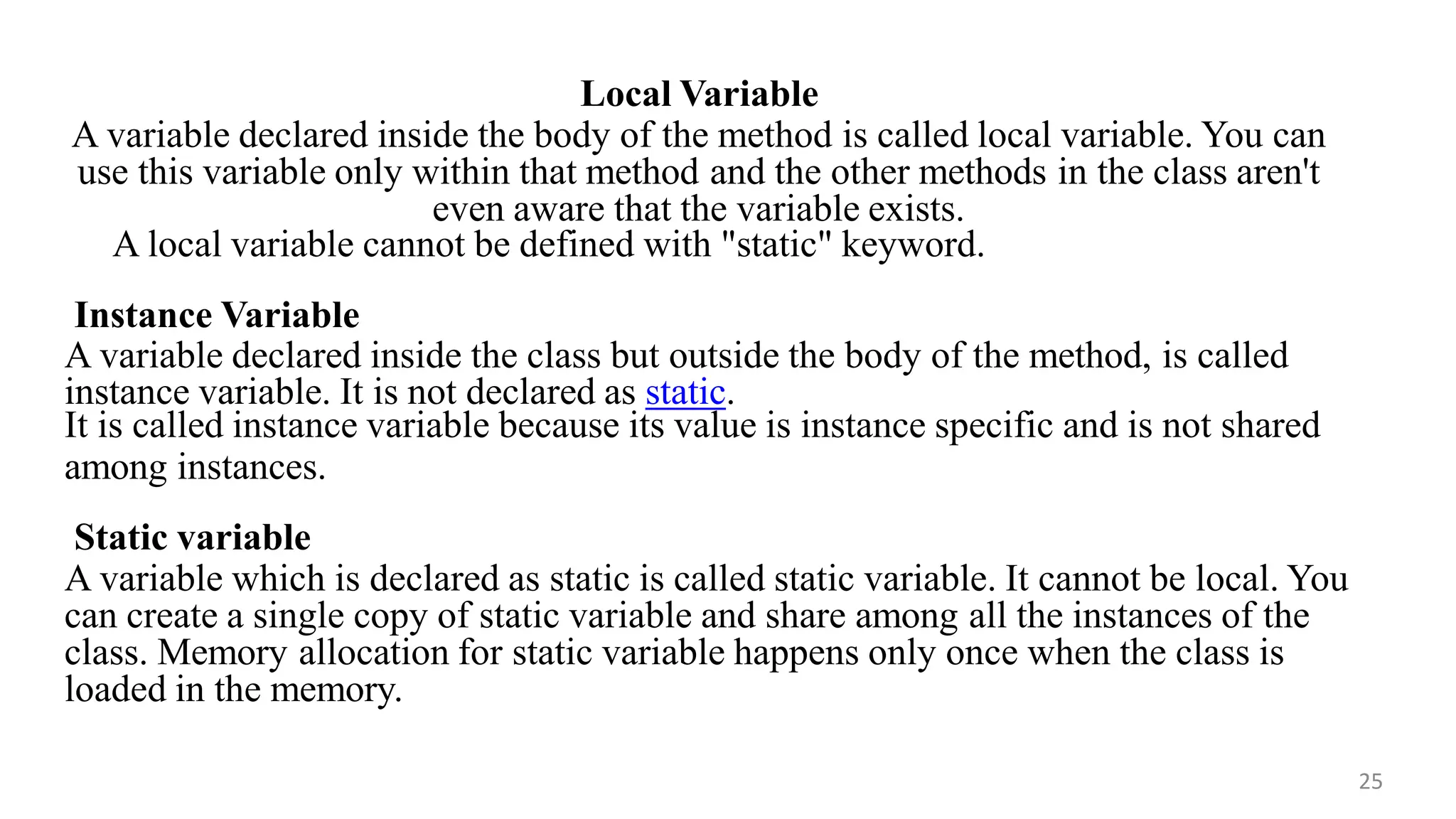
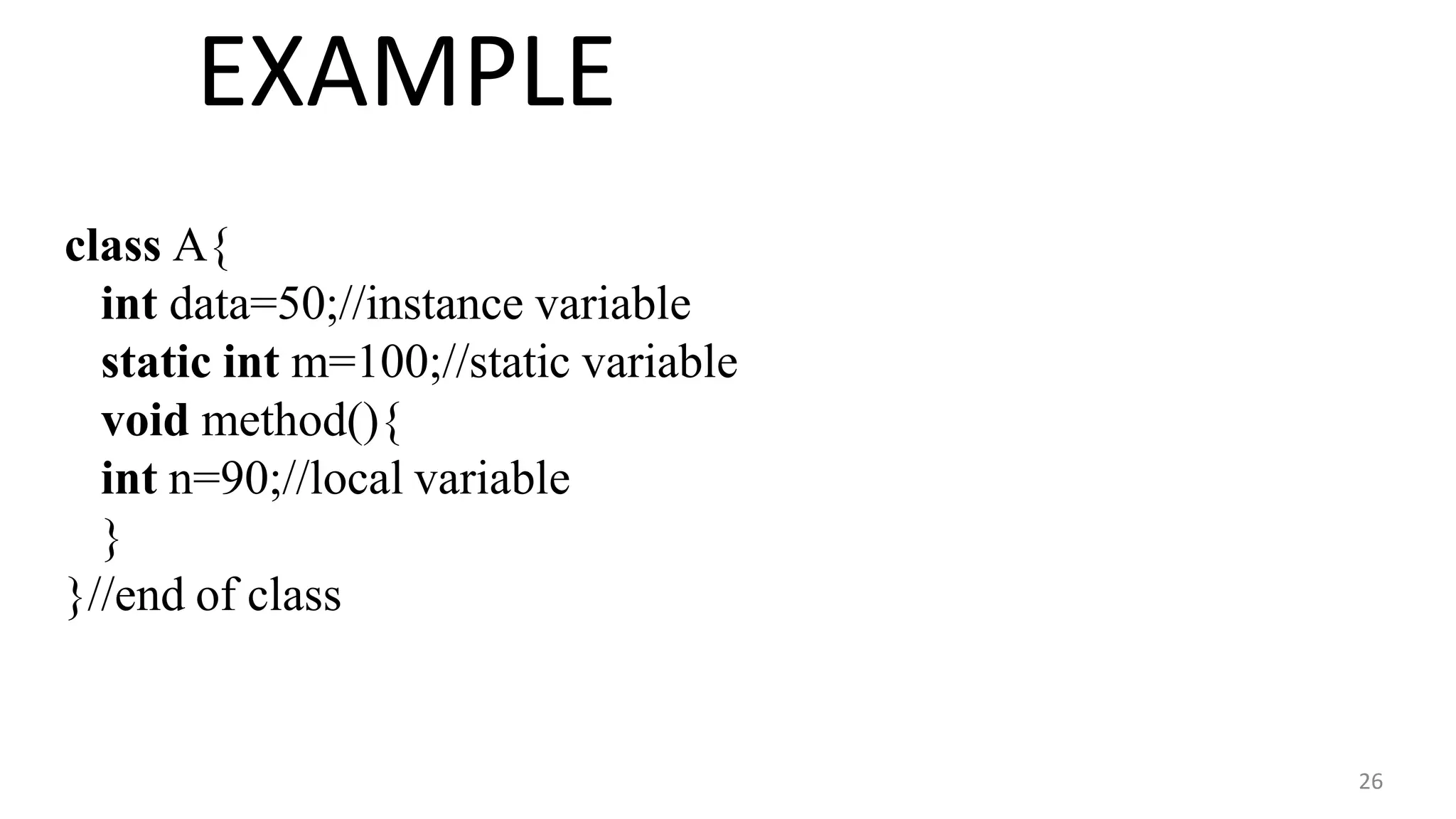

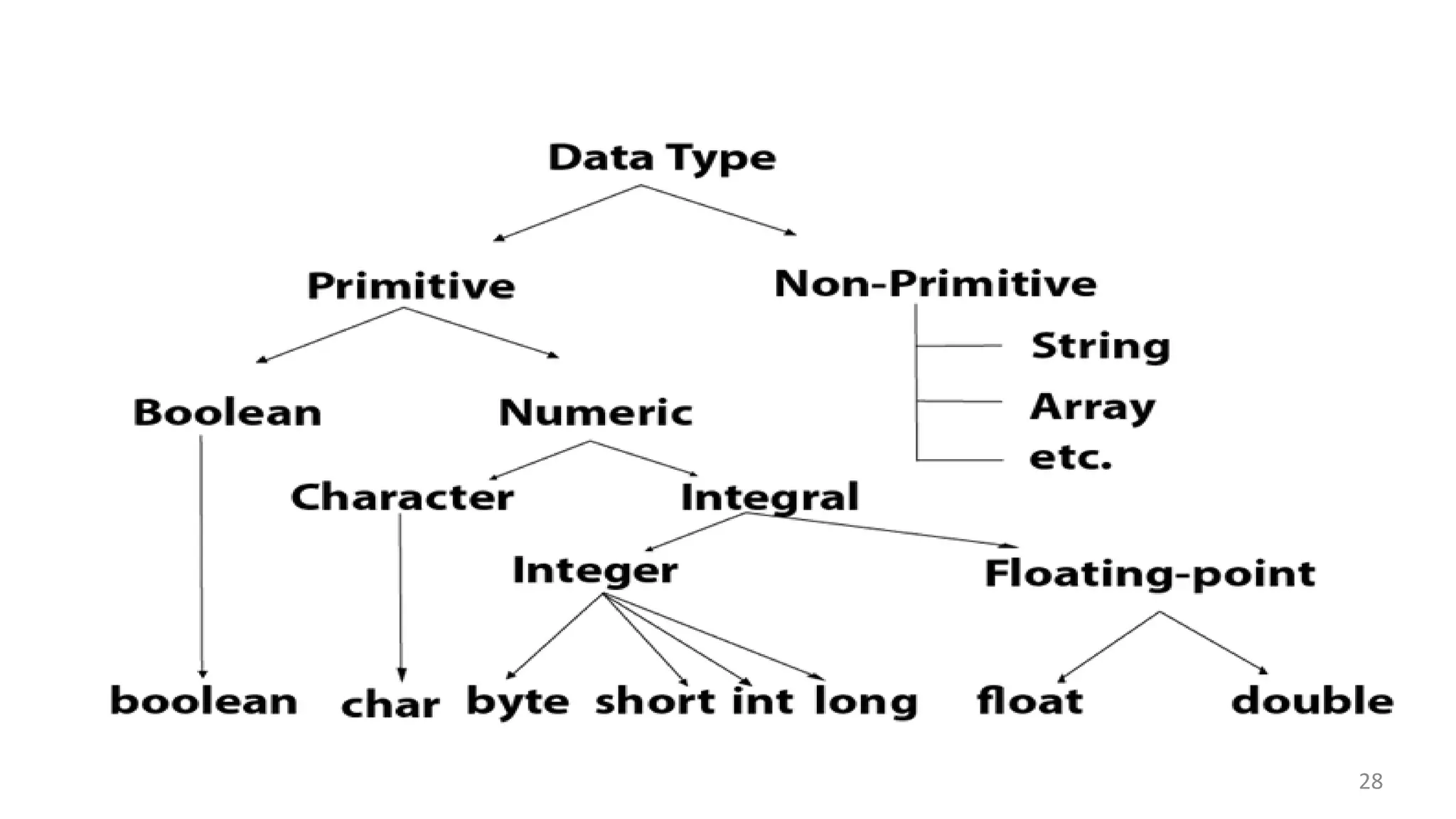
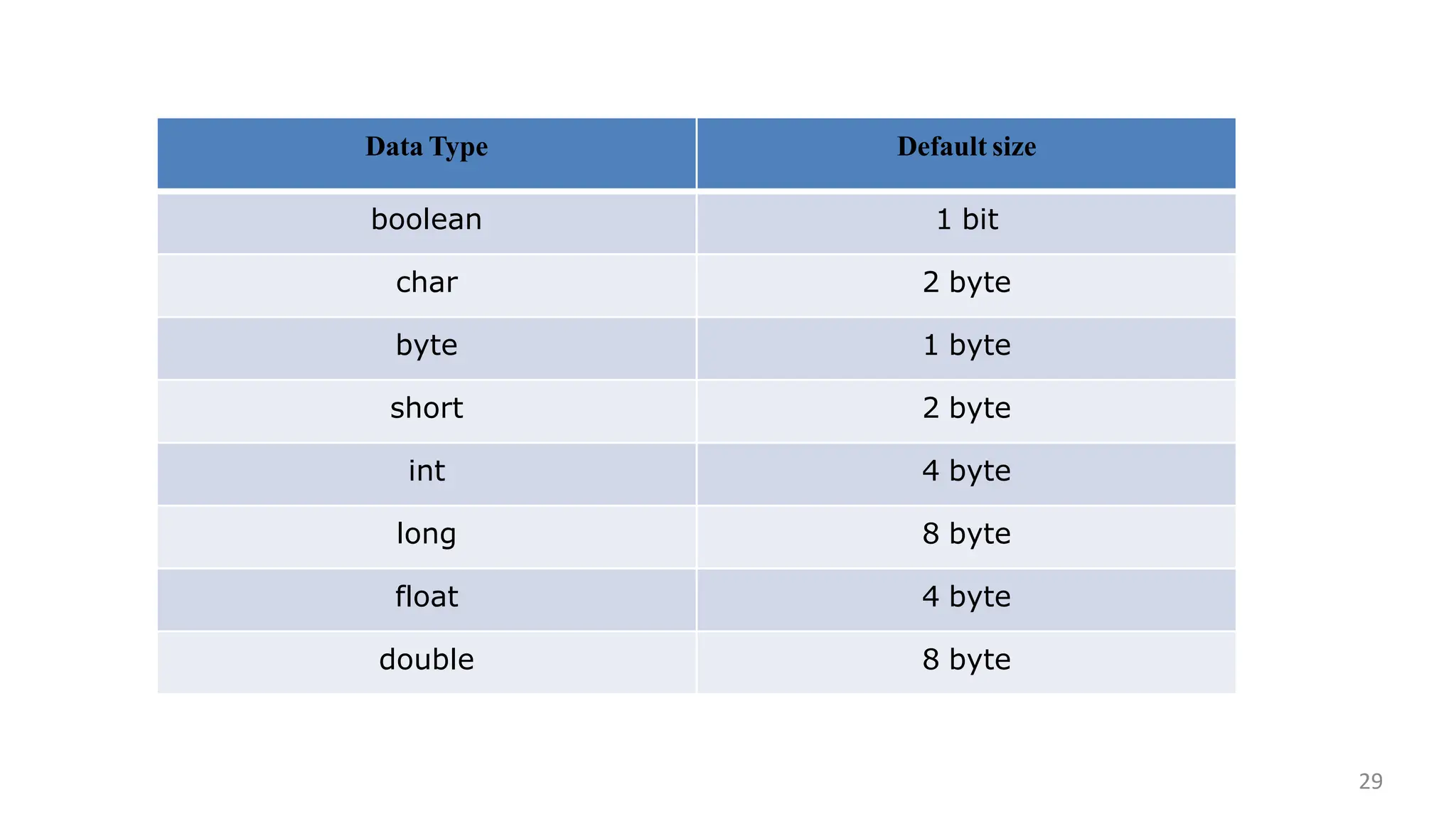

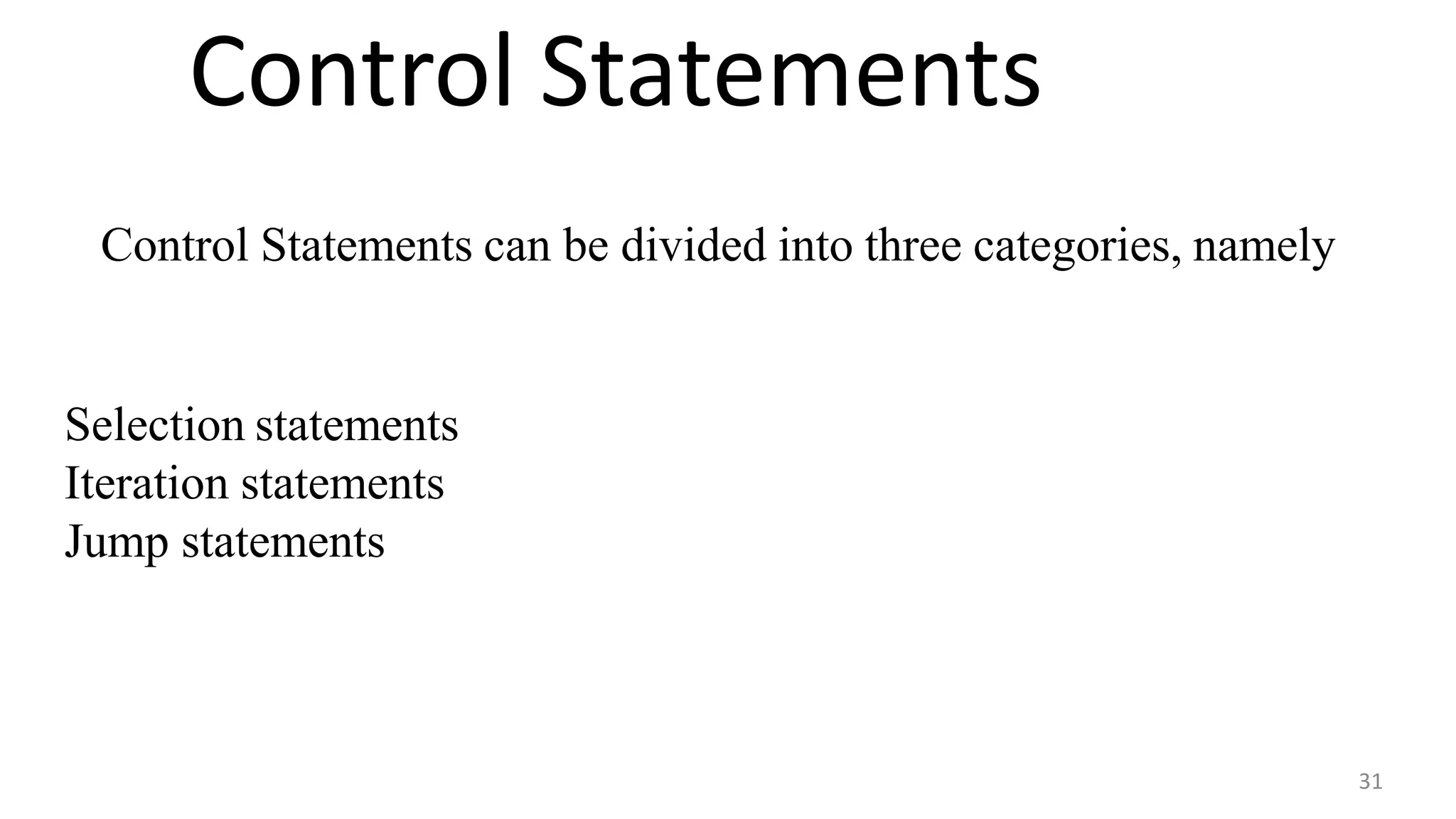
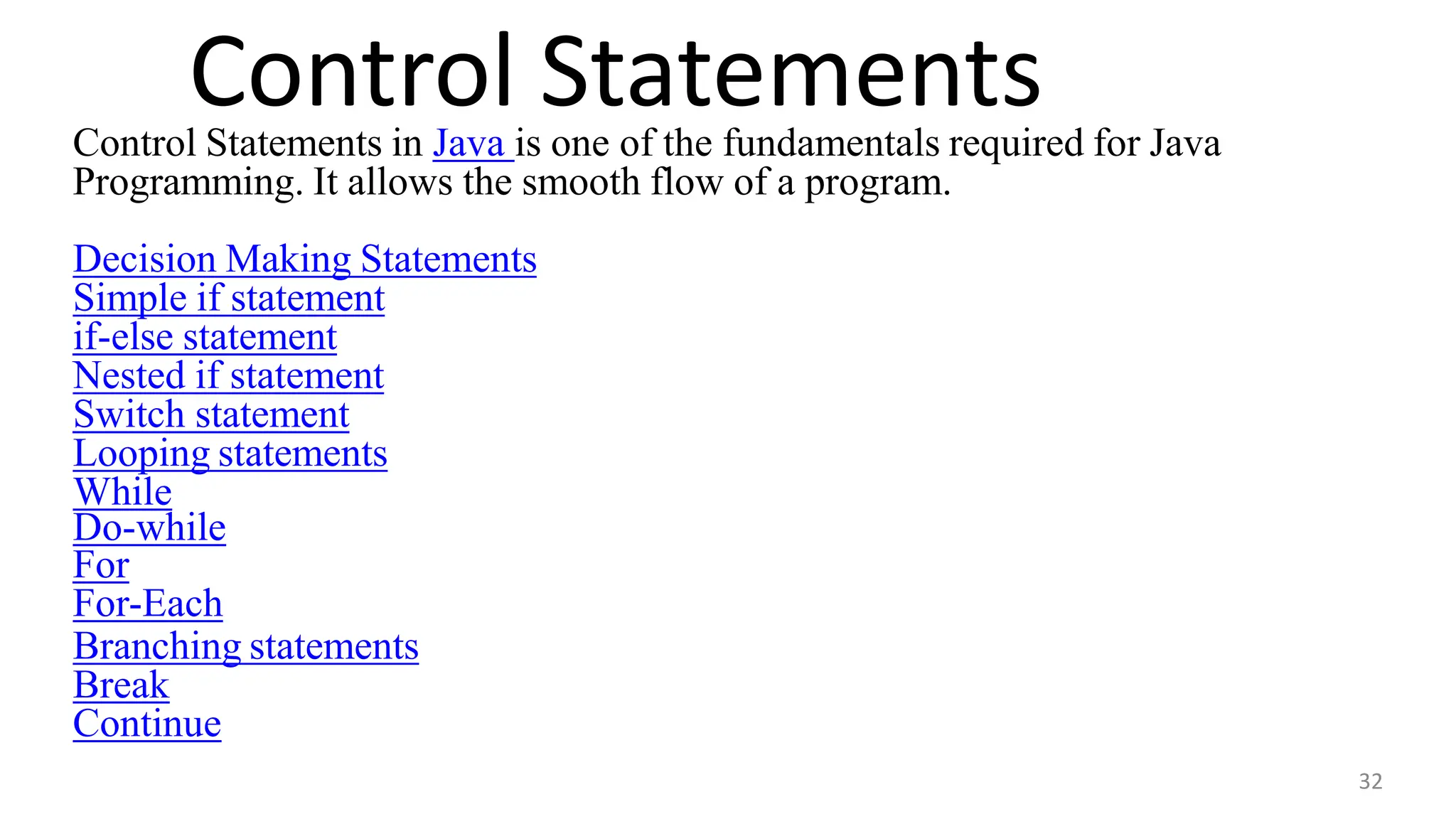
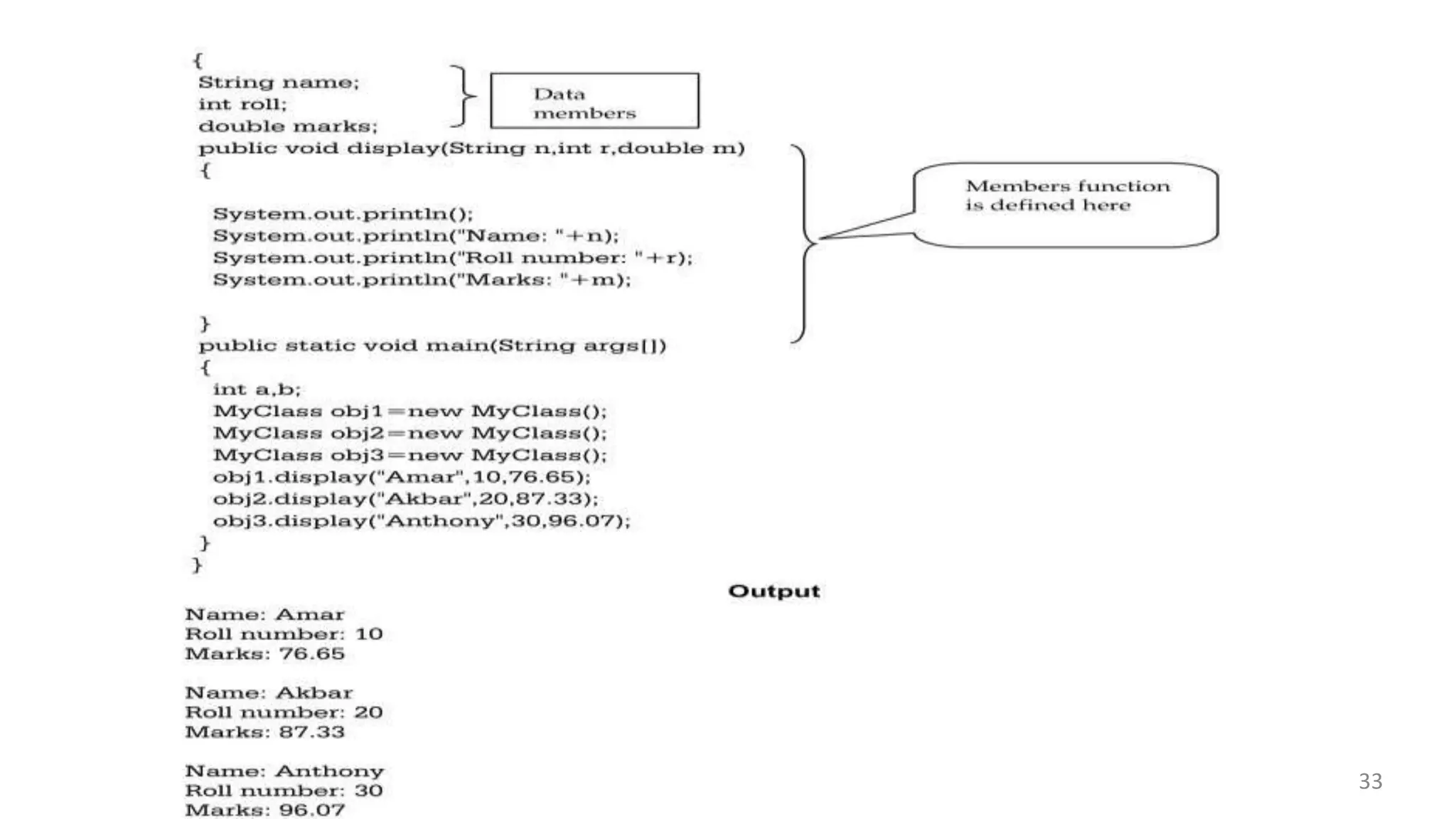
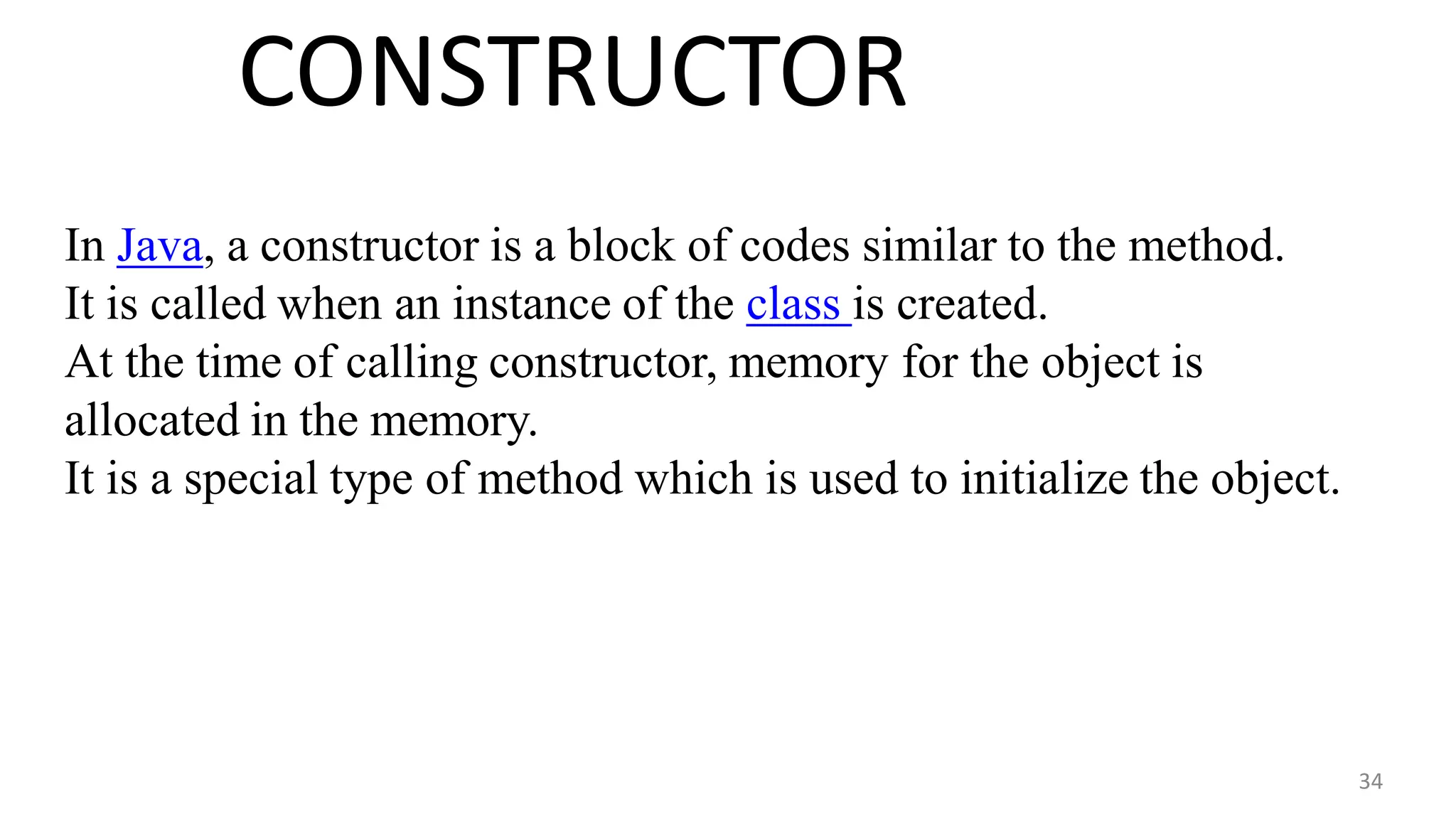

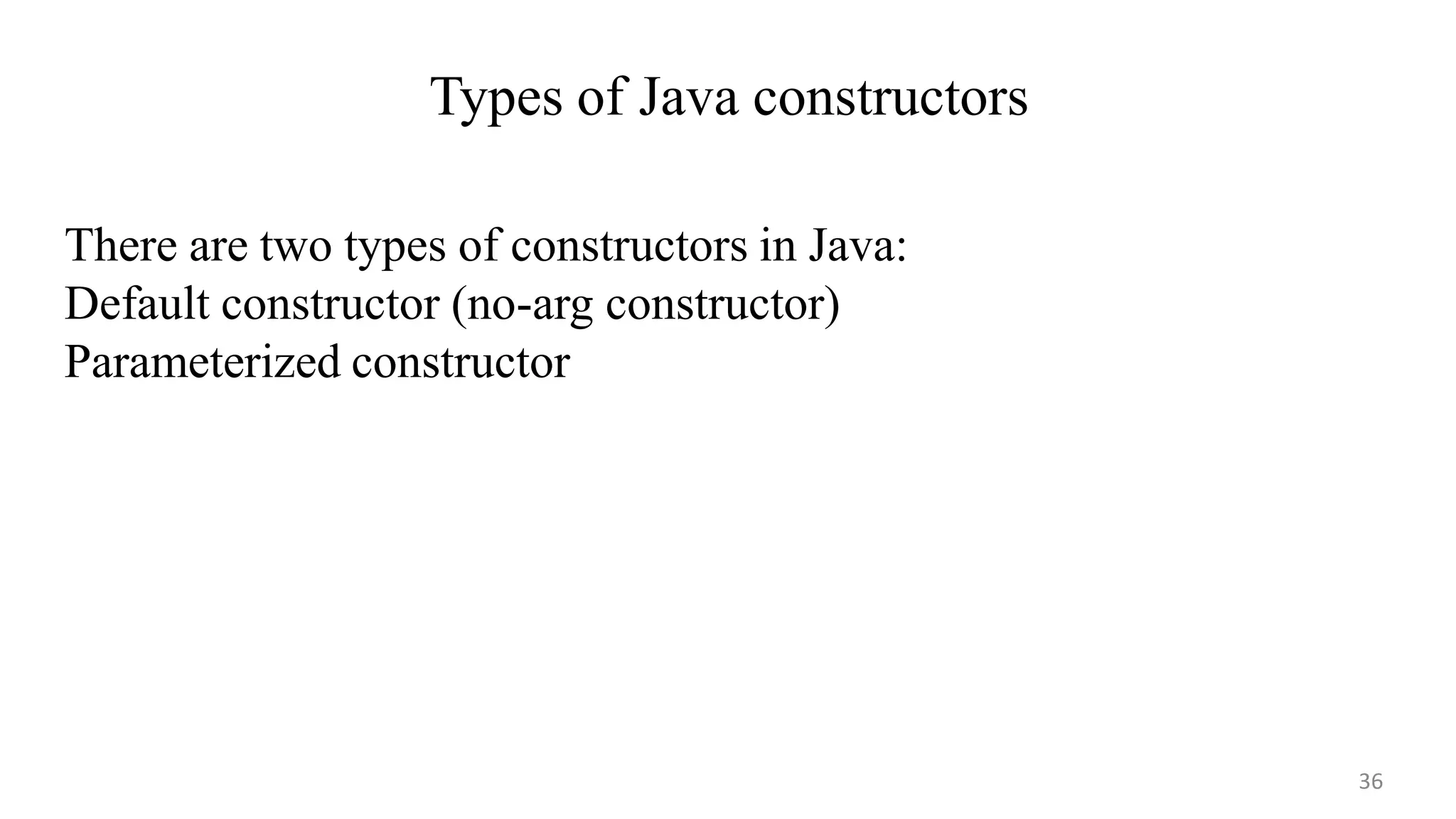
![Java Default Constructor
37
A constructor is called "Default Constructor" when it doesn't have any parameter
class Bike1{
//creating a default constructor
Bike1()
{
System.out.println("Bike is created");
}
public static void main(String args[])
{
Bike1 b=new Bike1();
} }
Output::
Bike is created](https://image.slidesharecdn.com/indumathy-unit1-240416141759-7b11f0e0/75/INDUMATHY-UNIT-1-cs3391-oops-introduction-to-oop-and-java-pptx-37-2048.jpg)
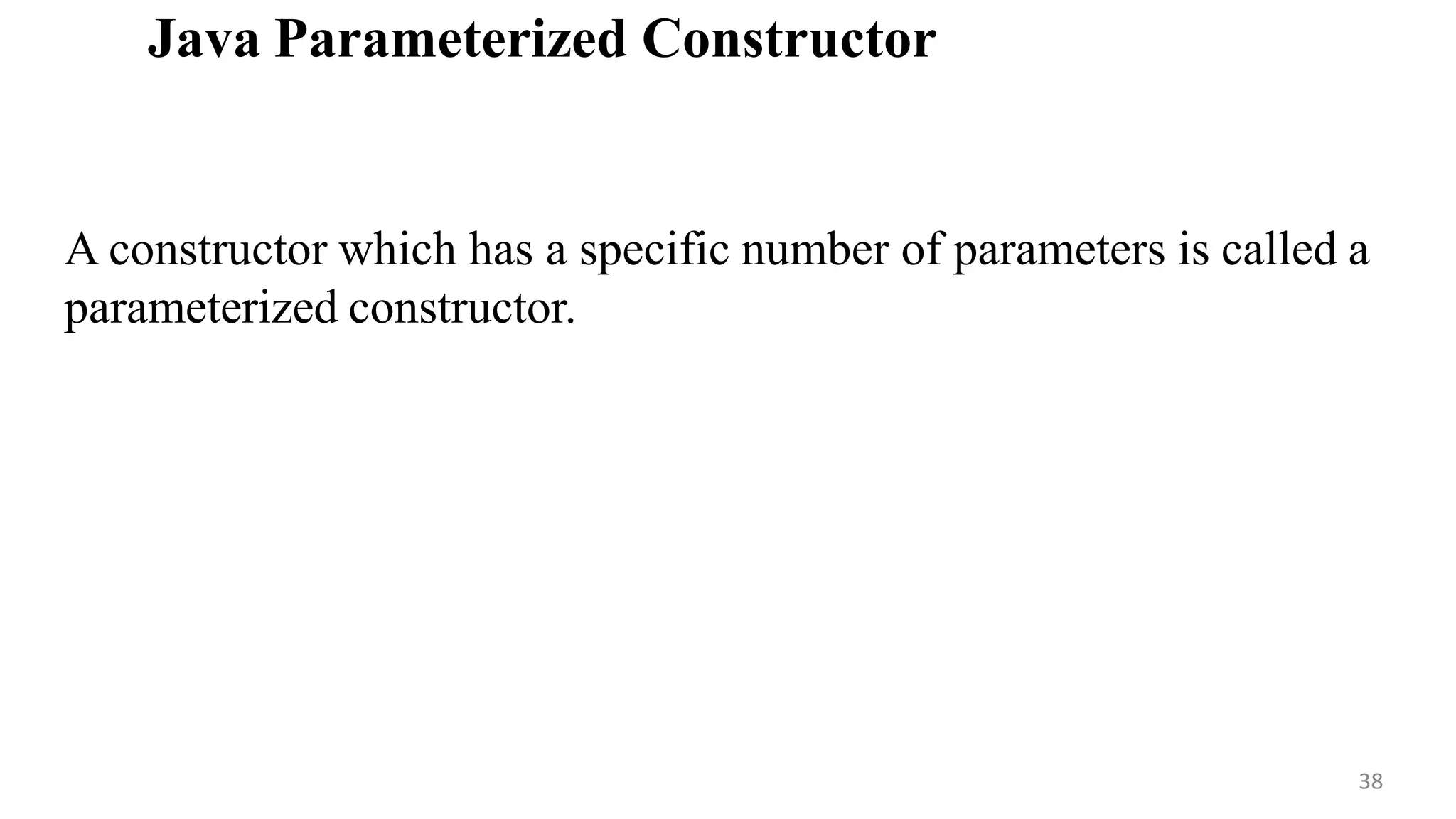
![class Student4{
int id;
String name;
39
Student4(int i,String n){
id = i;
name = n; }
Voiddisplay(){
System.out.println(id+" "+name);}
public static void main(String args[]){
Student4 s1 = new Student4(111,"Karan");
Student4 s2 = new Student4(222,"Aryan");
s1.display();
s2.display(); } }
OUTPUT:
111 Karan](https://image.slidesharecdn.com/indumathy-unit1-240416141759-7b11f0e0/75/INDUMATHY-UNIT-1-cs3391-oops-introduction-to-oop-and-java-pptx-39-2048.jpg)
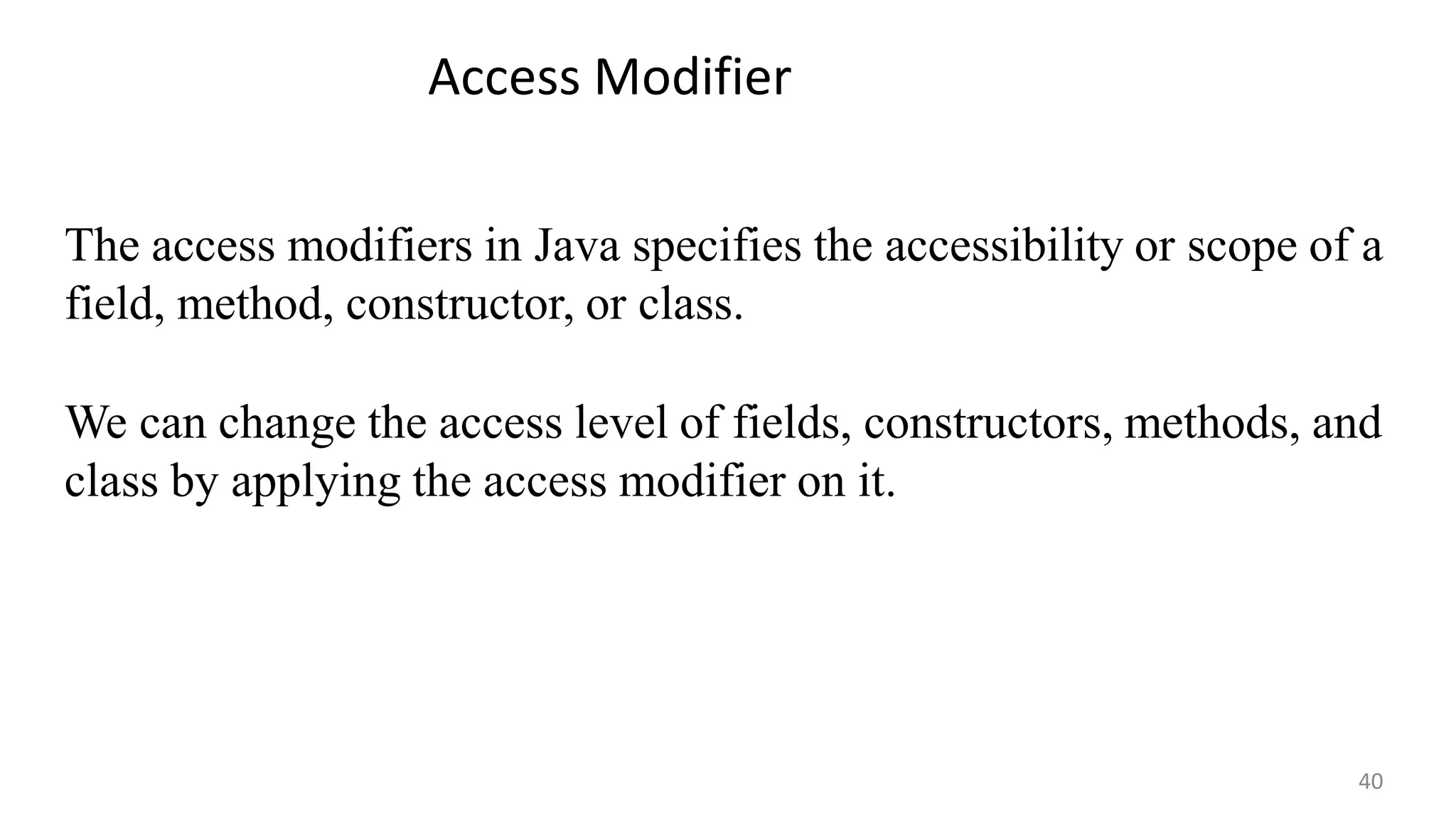
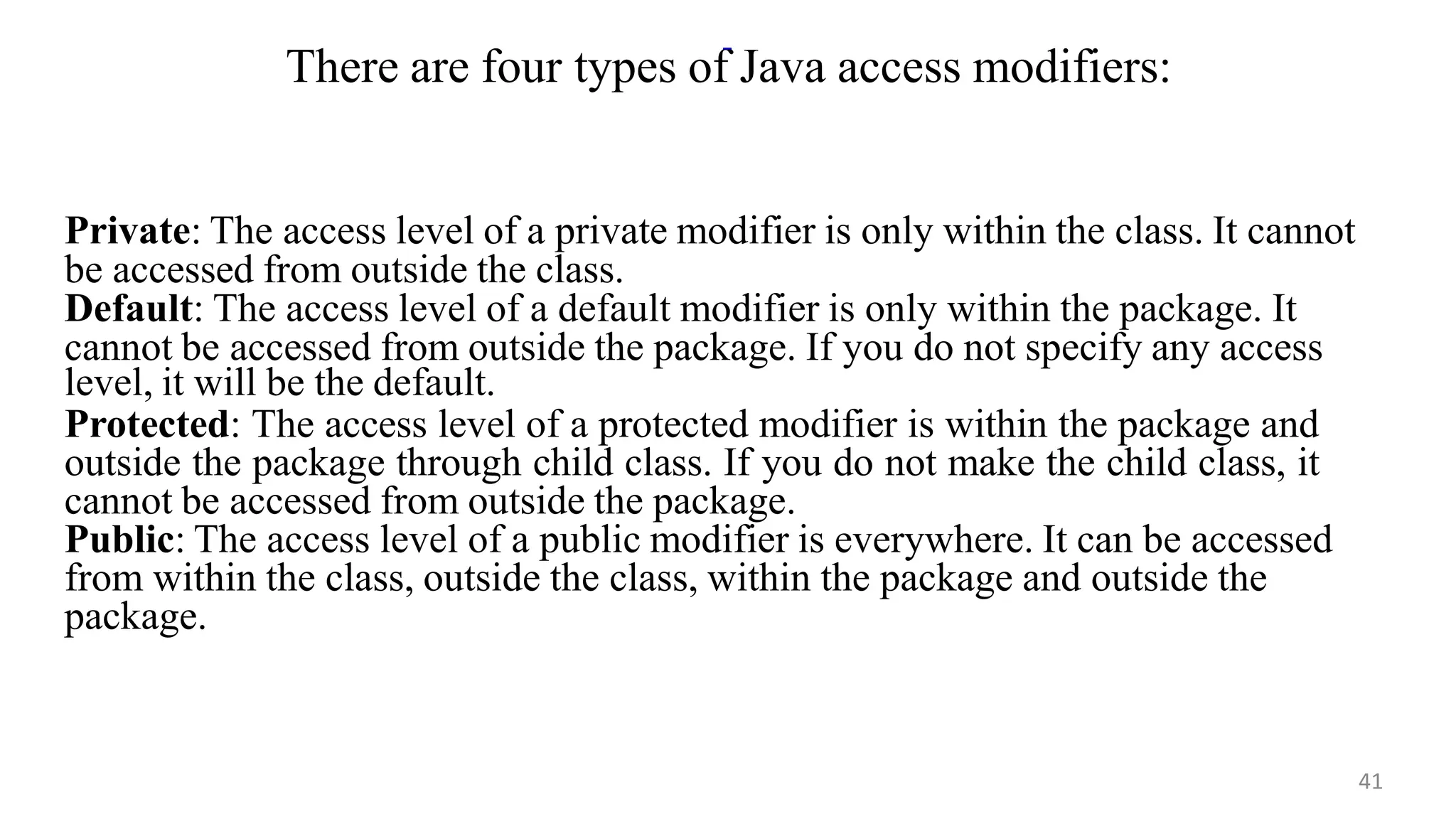
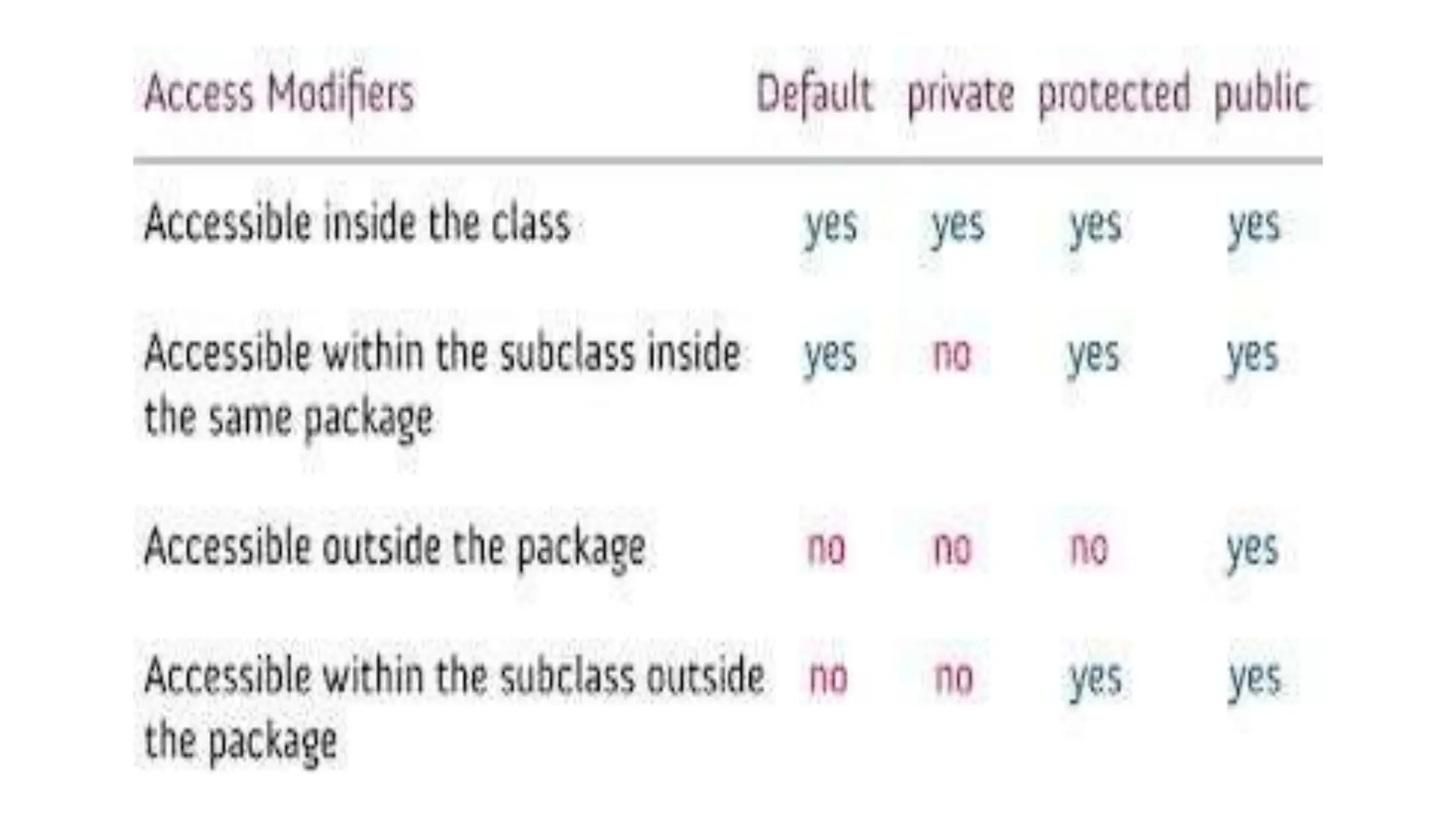
![Private
43
The private access modifier is accessible only within the class.
class A{
private int data=40;
private void msg(){System.out.println("Hello java");}
}
public class Simple{
public static void main(String args[]){
A obj=new A();
System.out.println(obj.data);//Compile Time Error
obj.msg();//Compile Time Error
}
}](https://image.slidesharecdn.com/indumathy-unit1-240416141759-7b11f0e0/75/INDUMATHY-UNIT-1-cs3391-oops-introduction-to-oop-and-java-pptx-43-2048.jpg)
![Role of Private
44
If you make any class constructor private, you cannot create the instance of that
class from outside the class
class A{
private A(){}//private constructor
void msg(){System.out.println("Hello java");}
}
public class Simple{
public static void main(String args[]){
A obj=new A();//Compile Time Error
}
}](https://image.slidesharecdn.com/indumathy-unit1-240416141759-7b11f0e0/75/INDUMATHY-UNIT-1-cs3391-oops-introduction-to-oop-and-java-pptx-44-2048.jpg)
![Default
45
If you don't use any modifier, it is treated as default by default. The default modifier
is accessible only within package. It cannot be accessed from outside the package.
package pack;
class A{
void msg(){System.out.println("Hello");}
}
package mypack;
import pack.*;
class B{
public static void main(String args[]){
A obj = new A();//Compile Time Error
obj.msg();//Compile Time Error
}](https://image.slidesharecdn.com/indumathy-unit1-240416141759-7b11f0e0/75/INDUMATHY-UNIT-1-cs3391-oops-introduction-to-oop-and-java-pptx-45-2048.jpg)
![Protected
46
The protected access modifier is accessible within package and outside the package but
through inheritance only.
//save by A.java
package pack;
public class A{
protected void msg(){System.out.println("Hello");}
}
//save by B.java
package mypack;
import pack.*;
class B extends A{
public static void main(String args[]){
B obj = new B();
obj.msg();
}
}](https://image.slidesharecdn.com/indumathy-unit1-240416141759-7b11f0e0/75/INDUMATHY-UNIT-1-cs3391-oops-introduction-to-oop-and-java-pptx-46-2048.jpg)
![Public
47
The public access modifier is accessible everywhere. It has the widest scope among all other
modifiers.
//save by A.java
package pack;
public class A{
public void msg(){System.out.println("Hello");}
}
//save by B.java
package mypack;
import pack.*;
class B{
public static void main(String args[]){
A obj = new A();
obj.msg();
}
}](https://image.slidesharecdn.com/indumathy-unit1-240416141759-7b11f0e0/75/INDUMATHY-UNIT-1-cs3391-oops-introduction-to-oop-and-java-pptx-47-2048.jpg)
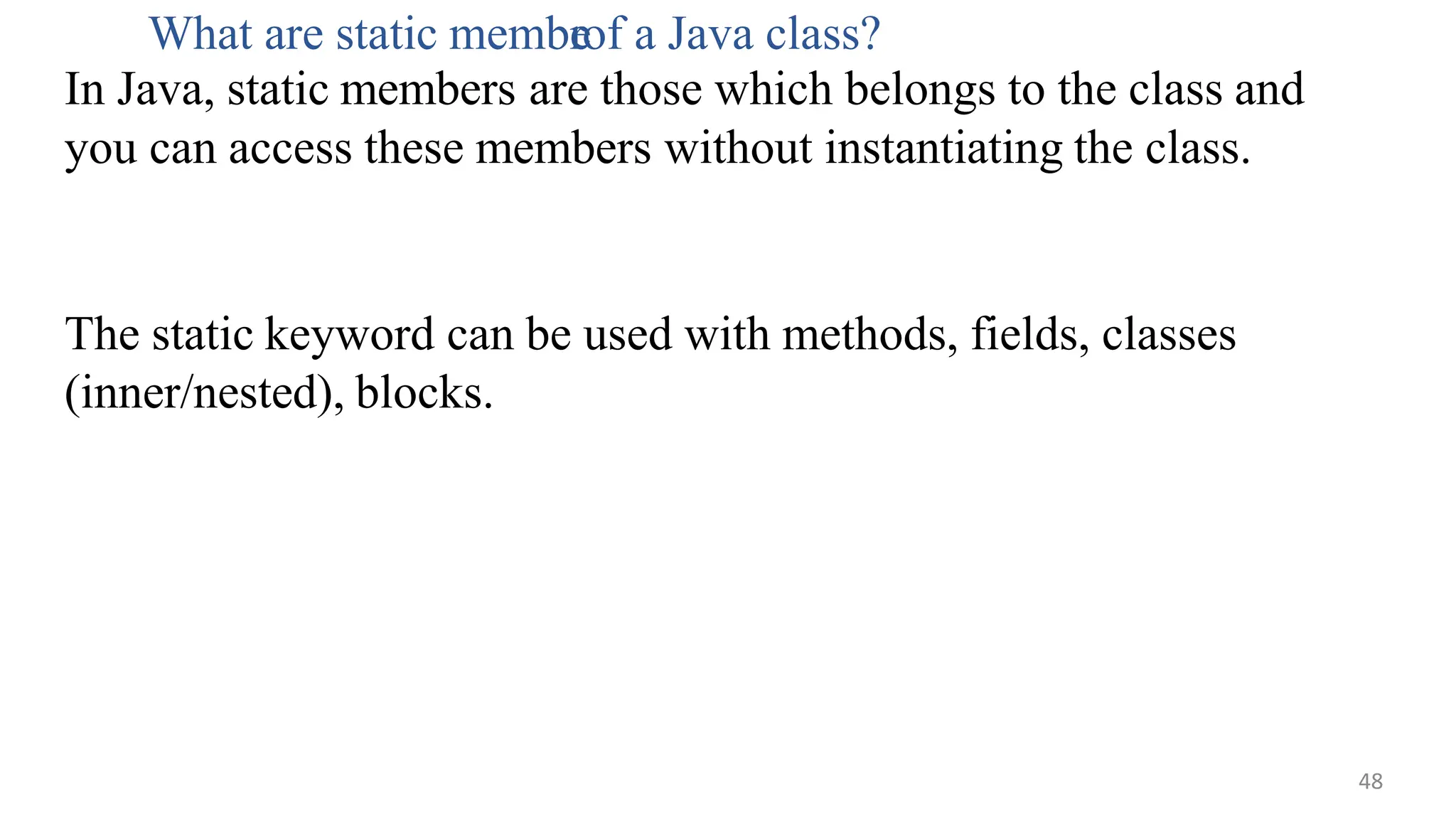
![STATIC METHOD
49
You can create a static method by using the keyword static. Static methods can access only static fields,
methods. To access static methods there is no need to instantiate the class, you can do it just using the class
name as
public class MyClass
{
public static void sample()
{
System.out.println("Hello");
}
public static void main(String args[])
{
MyClass.sample();
}
}](https://image.slidesharecdn.com/indumathy-unit1-240416141759-7b11f0e0/75/INDUMATHY-UNIT-1-cs3391-oops-introduction-to-oop-and-java-pptx-49-2048.jpg)
![Static Fields
50
You can create a static field by using the keyword static. The static fields have
the same value in all the instances of the class. These are created and initialized
when the class is loaded for the first time.
Just like static methods you can access static fields using the class name
public class MyClass {
public static int data = 20;
public static void main(String args[]){](https://image.slidesharecdn.com/indumathy-unit1-240416141759-7b11f0e0/75/INDUMATHY-UNIT-1-cs3391-oops-introduction-to-oop-and-java-pptx-50-2048.jpg)
![Static Blocks
51
These are a block of codes with a static keyword. In general, these
are used to initialize the static members. JVM executes static blocks
before the main method at the time of class loading.
public class MyClass {
static{
System.out.println("Hello this is a static block");
}
public static void main(String args[]){ System.out.println("This
is main method");](https://image.slidesharecdn.com/indumathy-unit1-240416141759-7b11f0e0/75/INDUMATHY-UNIT-1-cs3391-oops-introduction-to-oop-and-java-pptx-51-2048.jpg)
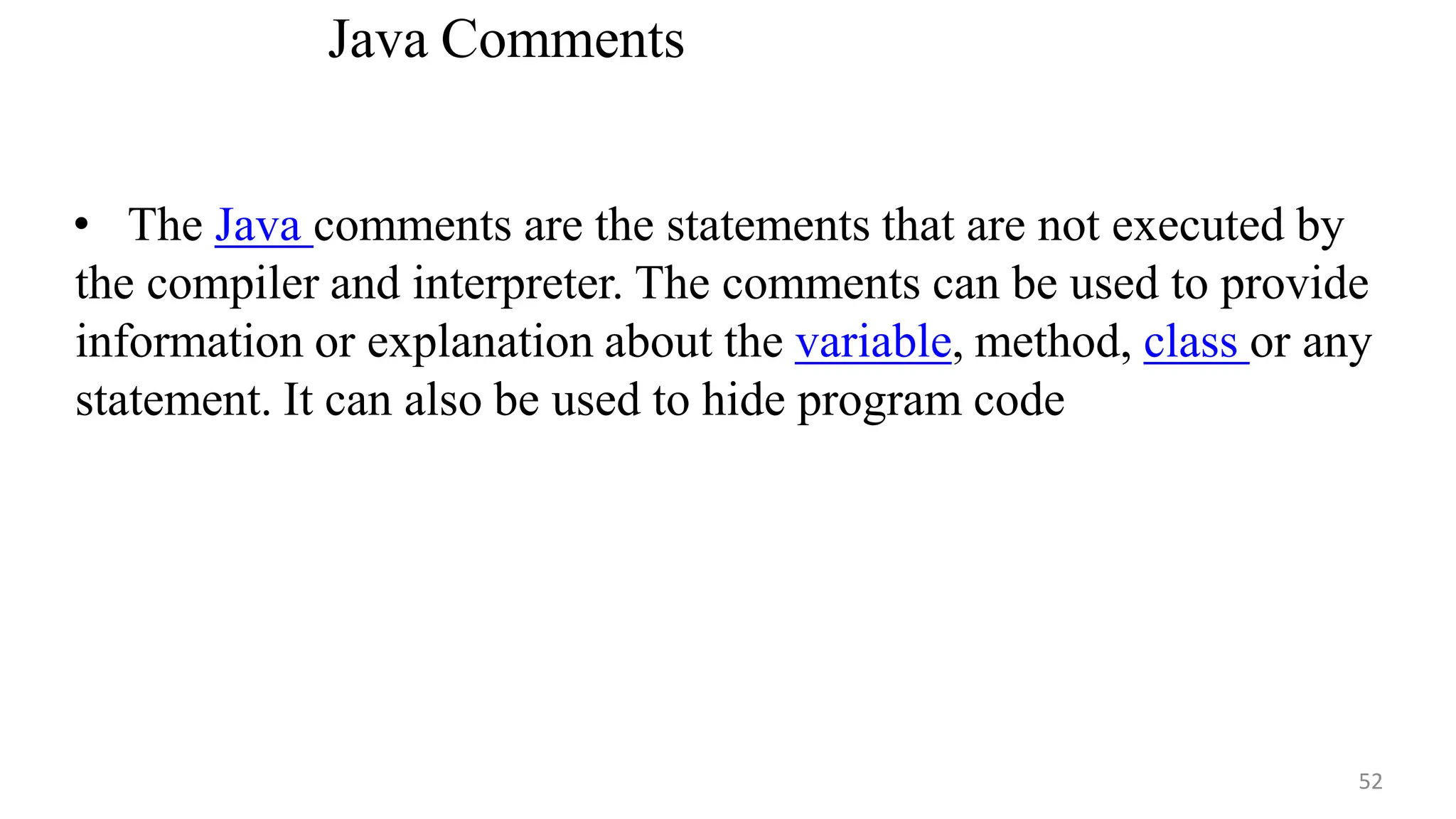
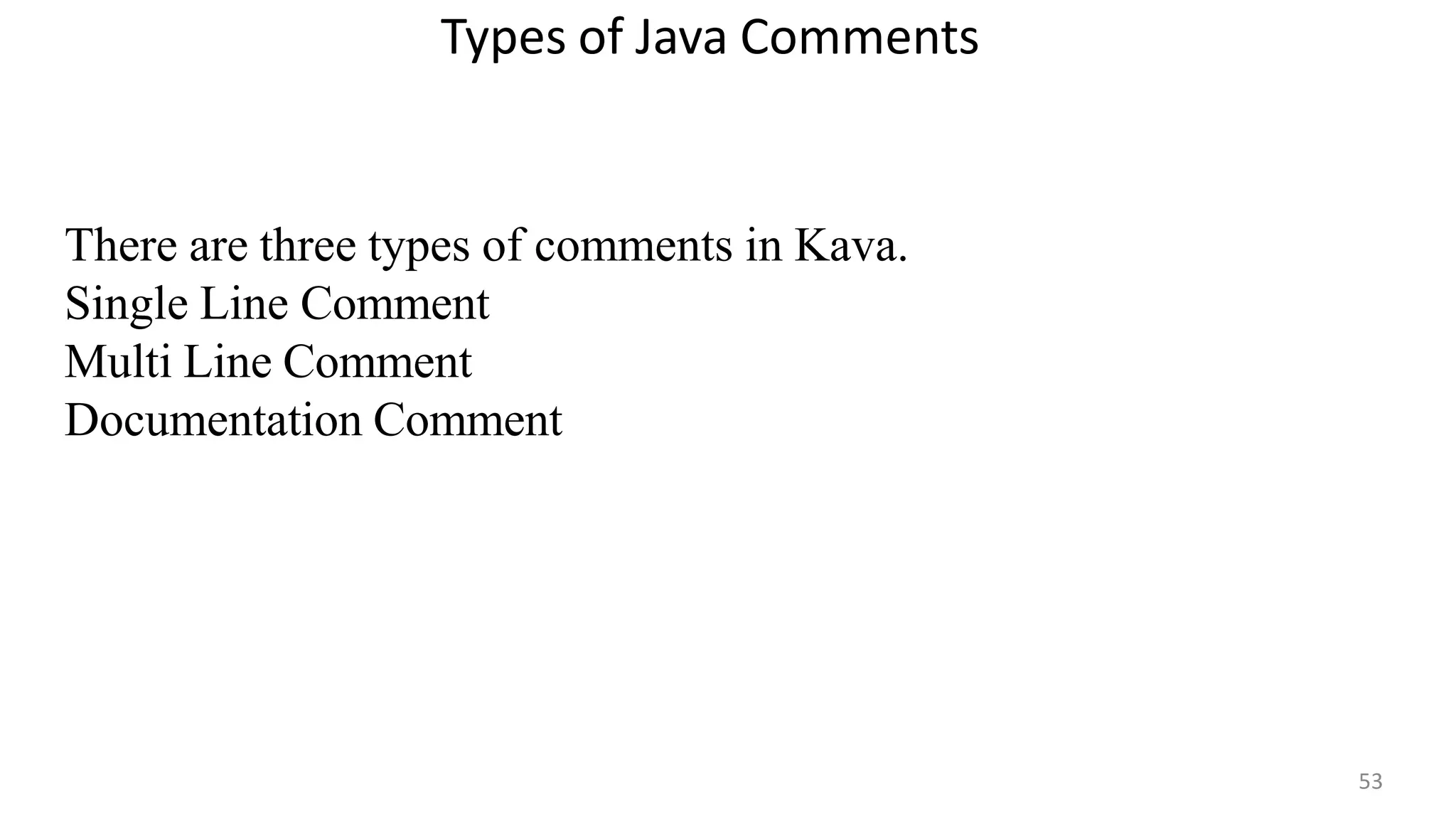
![Java Single Line Comment
54
Syntax:
//This is single line comment
Example:
public class CommentExample1 {
public static void main(String[] args) {
int i=10;//Here, i is a variable
System.out.println(i);
}
}
Output:
10](https://image.slidesharecdn.com/indumathy-unit1-240416141759-7b11f0e0/75/INDUMATHY-UNIT-1-cs3391-oops-introduction-to-oop-and-java-pptx-54-2048.jpg)
![Java Multi Line Comment
55
Syntax:
/*
This
is
multi line
comment
*/
Example:
public class CommentExample2 {
public static void main(String[] args) {
/* Let's declare and
print variable in java. */
int i=10;
System.out.println(i);
}
}
Output:](https://image.slidesharecdn.com/indumathy-unit1-240416141759-7b11f0e0/75/INDUMATHY-UNIT-1-cs3391-oops-introduction-to-oop-and-java-pptx-55-2048.jpg)
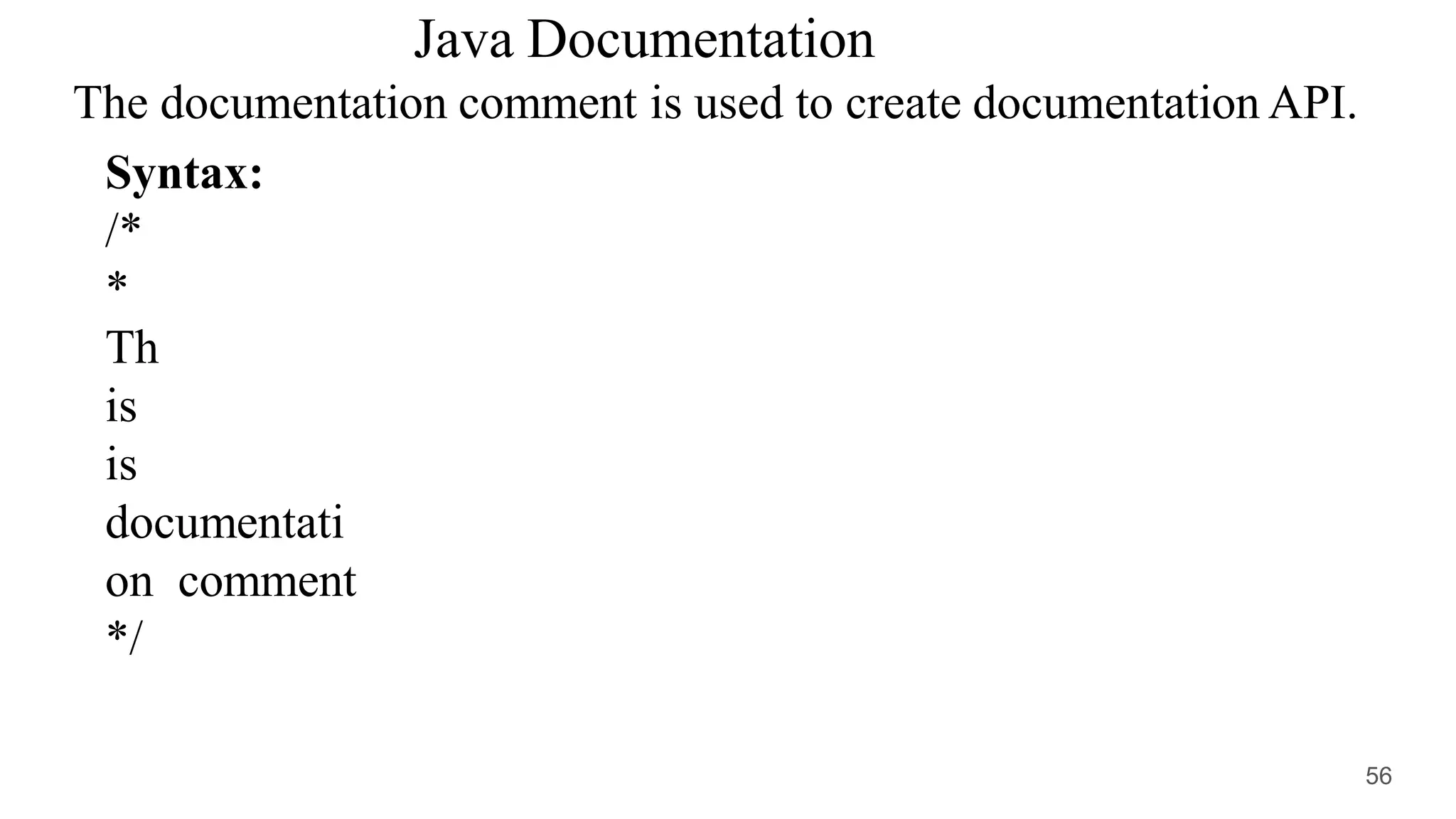
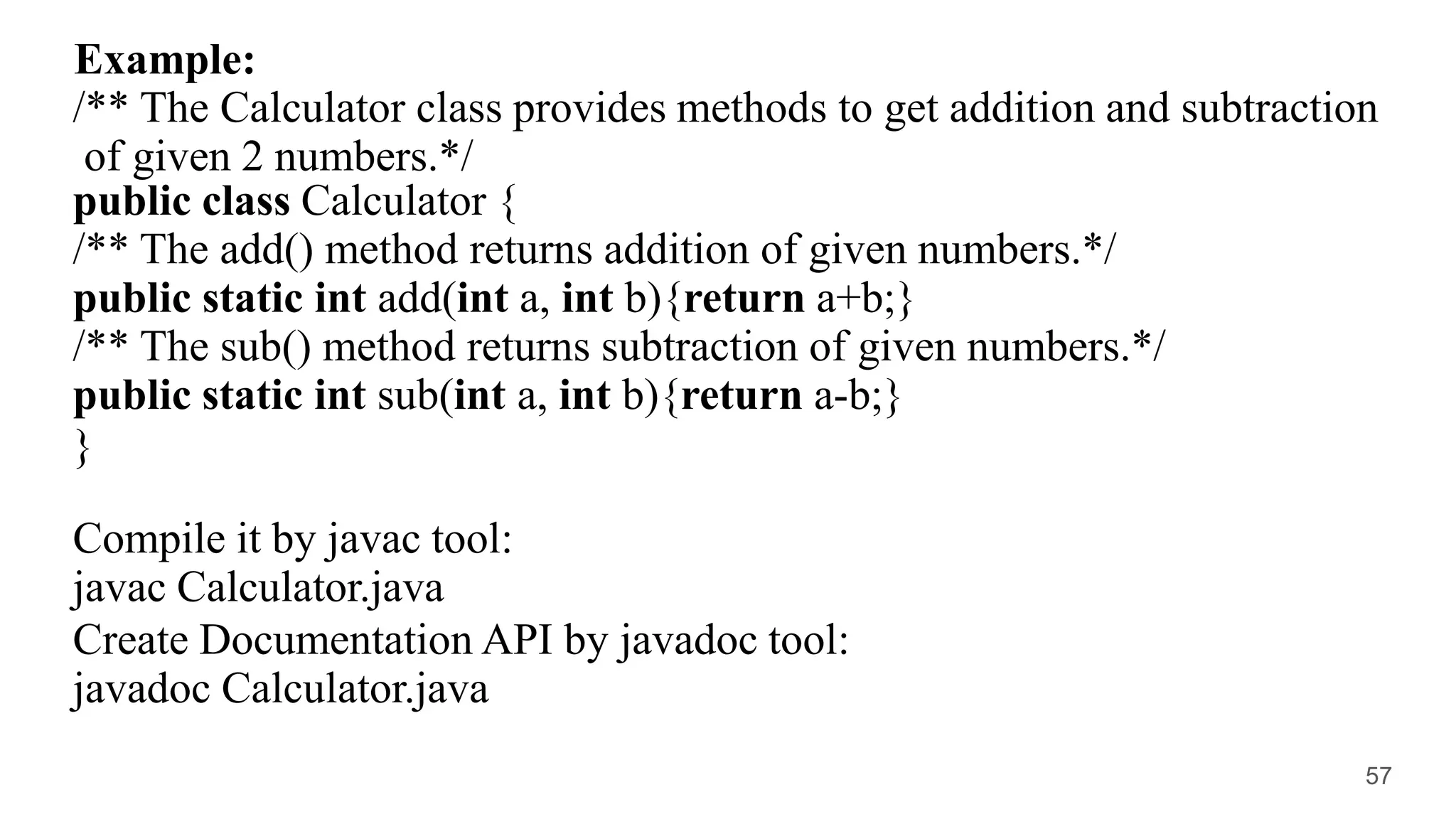

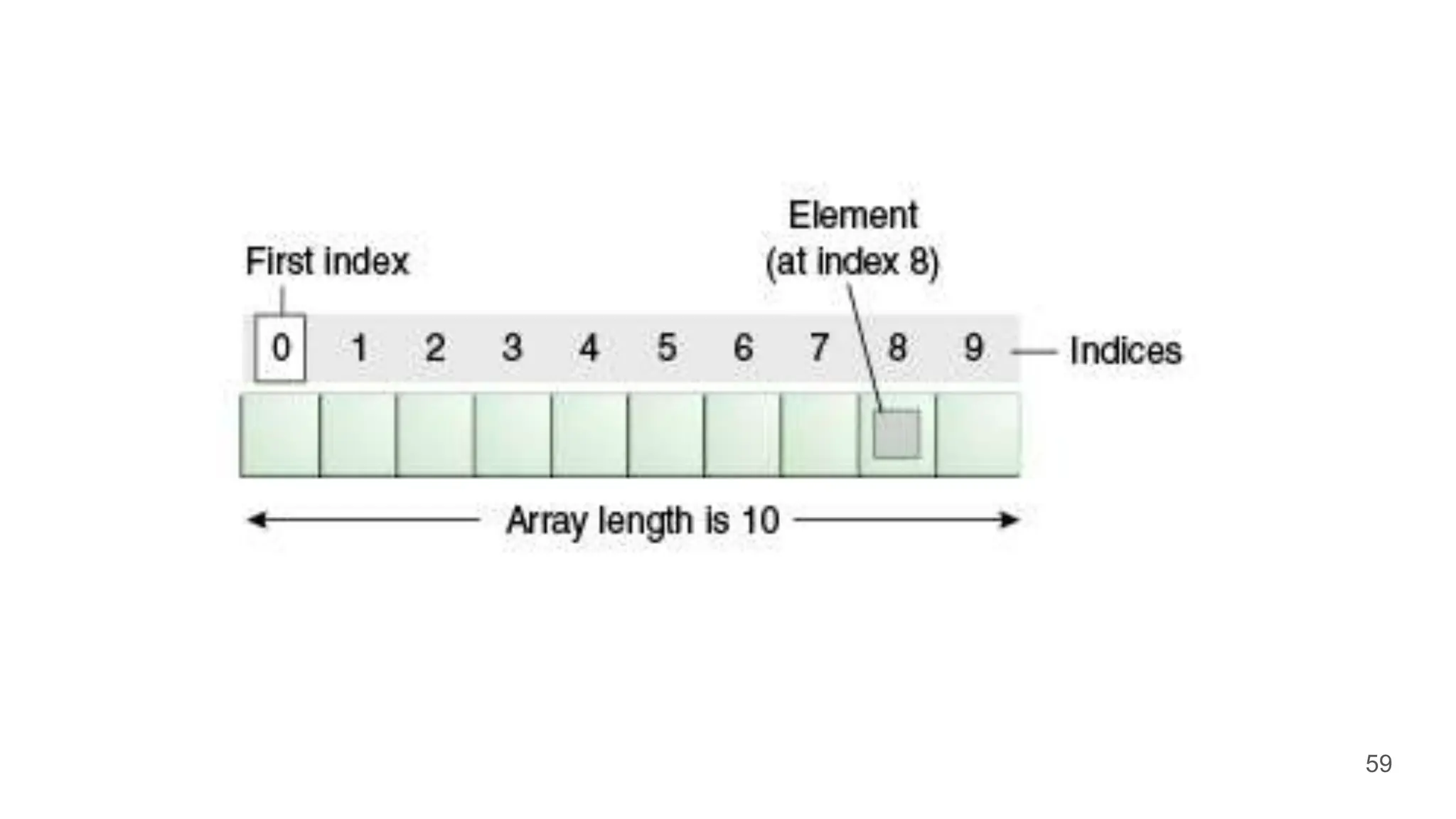
![Array Declaration
Example 1: Declaring an array which holds elements of integer type.
int aiMyArray[];
Different way of declaring an array –
int []aiMyArray;
int aiMyArray[];
The below statement declares, constructs and initializes the array.
int aiFirstArray[]={1,2,3,4,5,6};
60](https://image.slidesharecdn.com/indumathy-unit1-240416141759-7b11f0e0/75/INDUMATHY-UNIT-1-cs3391-oops-introduction-to-oop-and-java-pptx-60-2048.jpg)
![dataType[] arrayName;
double[] data;
data = new Double[10];
The size of an array is also known as the length of an array.
Note: Once the length of the array is defined, it cannot be changed
in the program.
But, how many elements can array this hold?
61](https://image.slidesharecdn.com/indumathy-unit1-240416141759-7b11f0e0/75/INDUMATHY-UNIT-1-cs3391-oops-introduction-to-oop-and-java-pptx-61-2048.jpg)
![Let's take another example:
int[] age;
age = new int[5];
Here, age is an array. It can hold 5 values of int type.
In Java, we can declare and allocate memory of an array in one
single statement. For example,
int[] age = new int[5];
62](https://image.slidesharecdn.com/indumathy-unit1-240416141759-7b11f0e0/75/INDUMATHY-UNIT-1-cs3391-oops-introduction-to-oop-and-java-pptx-62-2048.jpg)
![class ArrayExample
{ public static void main(String[] args) {
int[] age = new int[5];
for (int i = 0; i < 5; ++i) {
System.out.println(age[i]);
} } }
Output:
0 0 0 0 0
63](https://image.slidesharecdn.com/indumathy-unit1-240416141759-7b11f0e0/75/INDUMATHY-UNIT-1-cs3391-oops-introduction-to-oop-and-java-pptx-63-2048.jpg)
![class ArrayExample {
public static void main(String[] args) {
int[] age = {12, 4, 5, 2, 5};
for (int i = 0; i < 5; ++i) {
System.out.println("Element at index " + i +": " + age[i]);
} } }
Output:
Element at index 0: 12
Element at index 1: 4
Element at index 2: 5
Element at index 3: 2
Element at index 4: 5
64](https://image.slidesharecdn.com/indumathy-unit1-240416141759-7b11f0e0/75/INDUMATHY-UNIT-1-cs3391-oops-introduction-to-oop-and-java-pptx-64-2048.jpg)
![How to access array elements?
class ArrayExample {
public static void main(String[] args)
{
int[] age = new int[5];
int age[2] = 14;
int age[0] = 34;
for (int i = 0; i < 5; ++i)
{
System.out.println("Element at index " + i +": " + age[i]); } } }
Output:
Element at index 0: 34
Element at index 1: 0
Element at index 2: 14
Element at index 3: 0
Element at index 4: 0
65](https://image.slidesharecdn.com/indumathy-unit1-240416141759-7b11f0e0/75/INDUMATHY-UNIT-1-cs3391-oops-introduction-to-oop-and-java-pptx-65-2048.jpg)
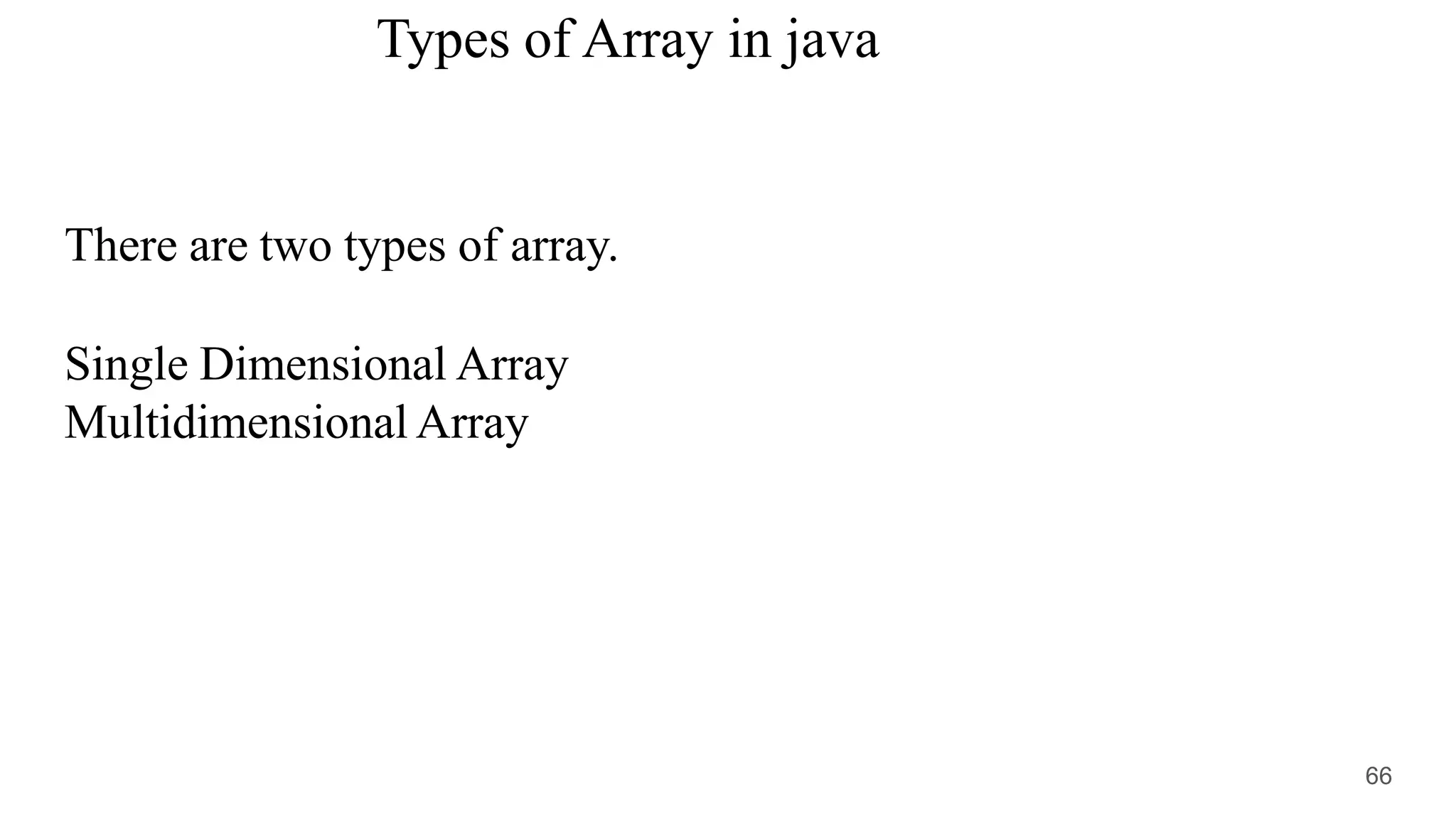
![class Testarray{
public static void main(String args[]){
int a[]=new int[5];
a[0]=10;
a[1]=20;
a[2]=70;
a[3]=40;
a[4]=50;
for(int i=0;i<a.length;i++)
System.out.println(a[i]);
}}
Output:
10 20 70 40 50
67](https://image.slidesharecdn.com/indumathy-unit1-240416141759-7b11f0e0/75/INDUMATHY-UNIT-1-cs3391-oops-introduction-to-oop-and-java-pptx-67-2048.jpg)
![Multidimensional Java Array
Syntax to Declare Multidimensional Array in Java
dataType[][] arrayRefVar; (or)
dataType [][]arrayRefVar; (or)
dataType arrayRefVar[][]; (or)
dataType []arrayRefVar[];
Example to instantiate Multidimensional Array in Java
int[][] arr=new int[3][3];//3 row and 3 column
Example to initialize Multidimensional Array in Java
arr[0][0]=1;
arr[0][1]=2;
arr[0][2]=3;
arr[1][0]=4;
arr[1][1]=5;
arr[1][2]=6;
arr[2][0]=7;
arr[2][1]=8;
arr[2][2]=9;
68](https://image.slidesharecdn.com/indumathy-unit1-240416141759-7b11f0e0/75/INDUMATHY-UNIT-1-cs3391-oops-introduction-to-oop-and-java-pptx-68-2048.jpg)
![class Testarray3{
public static void main(String args[]){
//declaring and initializing 2D array
int arr[][]={{1,2,3},{2,4,5},{4,4,5}};
//printing 2D array
for(int i=0;i<3;i++){
for(int j=0;j<3;j++){
System.out.print(arr[i][j]+" ");
}
System.out.println();
}
}}
69](https://image.slidesharecdn.com/indumathy-unit1-240416141759-7b11f0e0/75/INDUMATHY-UNIT-1-cs3391-oops-introduction-to-oop-and-java-pptx-69-2048.jpg)
